World Cat Congress
Las Vegas Nevada 2017
American Curl Presentation
Thank you Mike,
Hi, my name is Grace Ruga, this is my husband Joe Ruga.
Some of you may recall, Joe personally presented our Curls before the Boards of both TICA and CFA, for every level of advancement towards achieving Championship Status.
The American Curl successfully advanced at every presentation.
Joe was also the primary voice and resolve in our insistence that both coat variations of the American Curl be accepted equally under the same breed name.
In 1993 when The American Curl was advanced to Championship Status in CFA, we made CFA History as the first breed accepted with both coat variations with one breed name, American Curl LH and American Curl SH. Thank you Joe, for being the ‘voice’ to attain that achievement!
Other breeds, for whom it opened doors previously closed, thank you as well!
Today, I will be sharing what influenced us as we wrote the American Curl Standard –
I will be using the current CFA American Curl Breed Standard as my “text”, for most of my comments today, focusing on the CORE IDENTITY TRAITS of the American Curl, within the Standard.
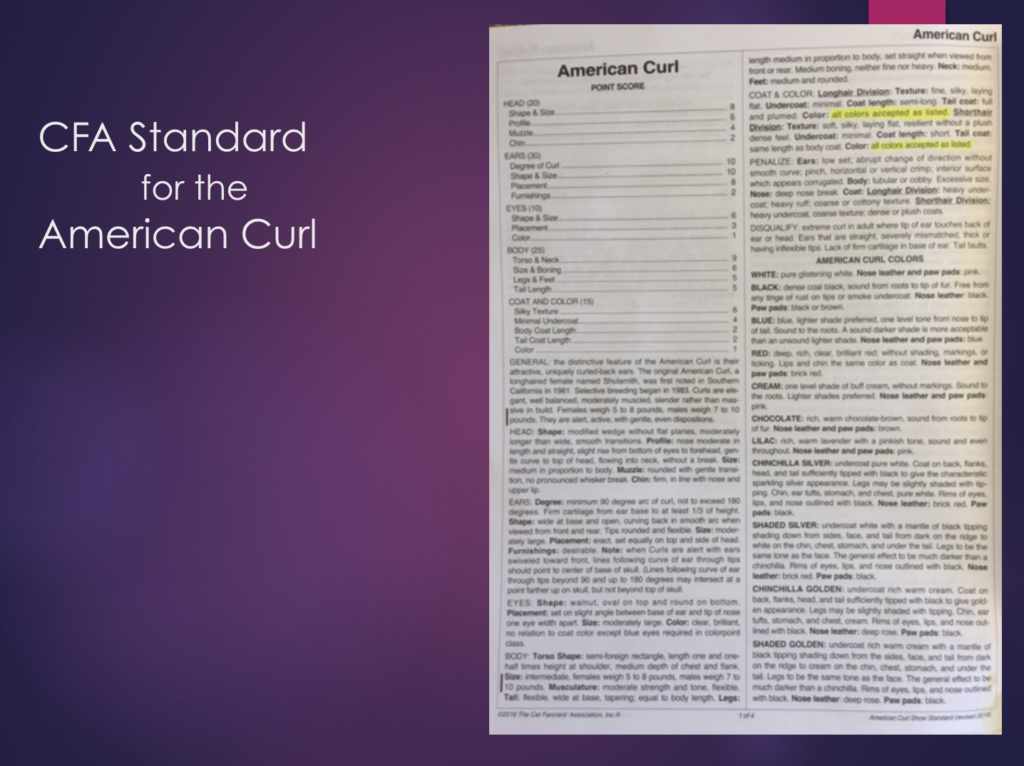
In my opinion, this Standard has retained the most of the original terminology, and physical intent we envisioned for the American Curl. I also think the Penalize and Disqualify categories are an integral part of our genetic protection, and encourage breeders and judges to use them in that context.
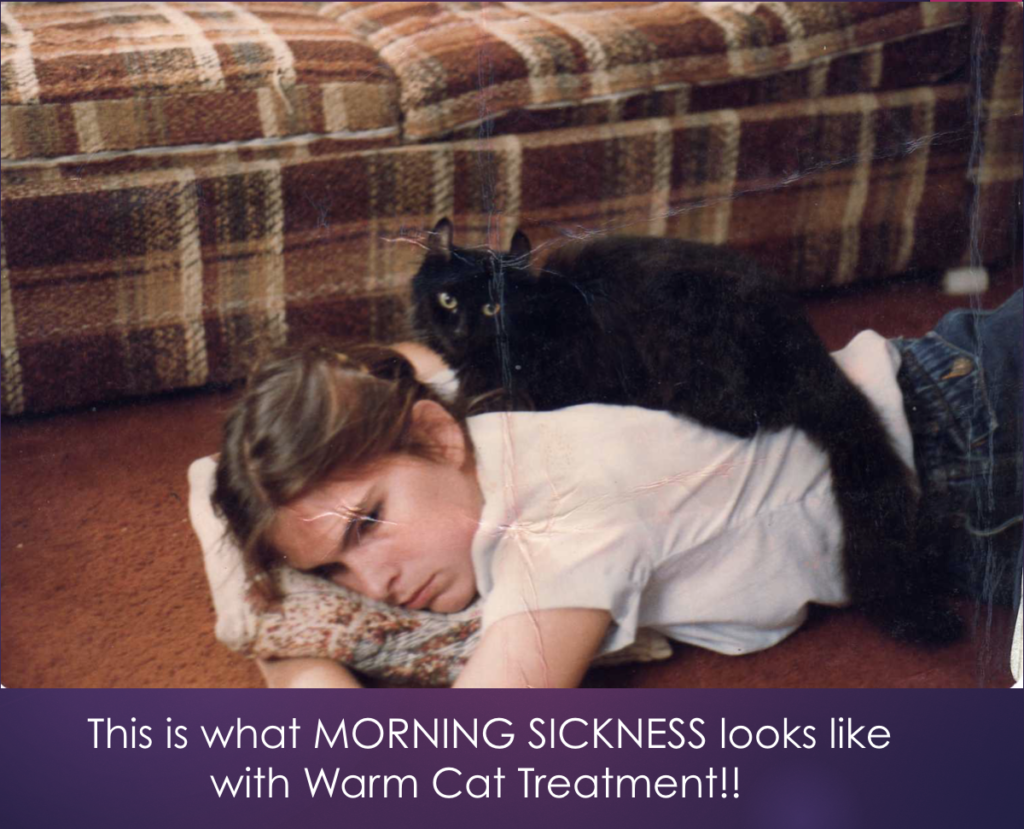
In 1981, we had not yet been married a year. I was 20, and Joe was 23. We had only lived in Lakewood CA a few months, and I was very pregnant, (and very sick)… when we took in a dainty, black stray cat, who came to be known to the world as Shulamith.
Shulamith had her first litter in 1981.
Most of you already know that part of the story.
Curly eared kittens had been placed with my sister Esther Brimlow and Joe’s co-worker Carol Keenan…Carol was given a male and female, siblings; with the intention of performing the first Curl-Curl breeding. That breeding was planned, in 1983. While waiting for the kittens to mature …
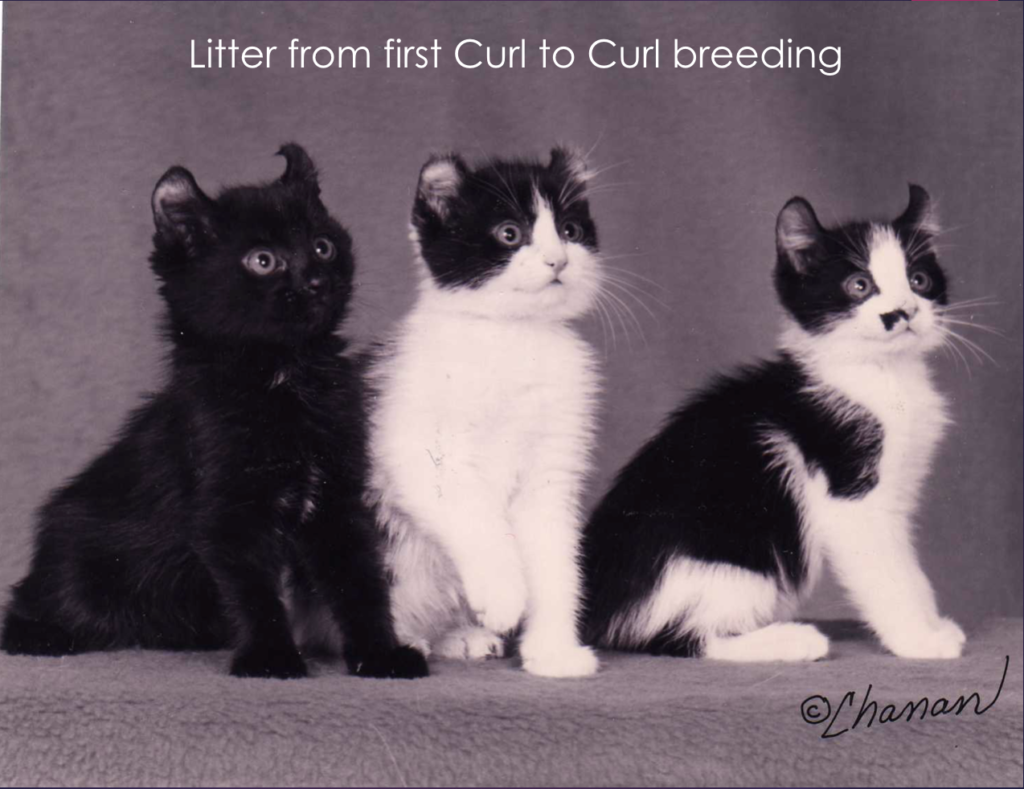
We were introduced to Jean Grimm, a Scottish Fold Breeder and a CFA judge…And Jean was introduced to our three generations of Curly eared cats, both longhair and shorthair, that came to be known as The American Curl.
Jean sat on the floor with Curls running all over, and as one came past she would pick it up and handle it then let it go and pick up another one….and said nothing for a very long time!
THEN…When she finally spoke…
Jean let us know that ‘What we had didn’t exist’! Anything with curly ears was unknown to the Cat Fancy. This NEEDED to be developed into a recognized breed. She went over the basics of what would be involved. She told us to expect it to take 20 years and a LOT of money spent, to attain championship Status in CFA. None of which we heard much of the first time she said it. We were still processing! It isn’t ‘normal’ to be told, an integral part of your family – ‘doesn’t exist’ – and that no one else has ever seen it!
*** slide of – Heading Introducing the American Curl!
The first thing we needed was a name and a Breed Standard.
We decided to follow the example of the Scottish Fold, and use the country of origin and the distinguishing trait to now be known as The American Curl.
With Jean Grimm’s assistance The American Curl was introduced to the Cat Fancy at a CFA show, as Exhibition Only in Palm Springs CA, October 23, 1983. *(Not my recommendation of how to celebrate a wedding anniversary weekend!)

None of the Curls there (Shulamith, with several of her children and grandchildren), would be considered show quality cats now, but they made quite a stir then!
Attending your very first cat show, which is a sub-culture of its own, with your own cats that become the center of attention, (and some ridicule), is a shock! –(Bob Salisbury made an indelible impression!)
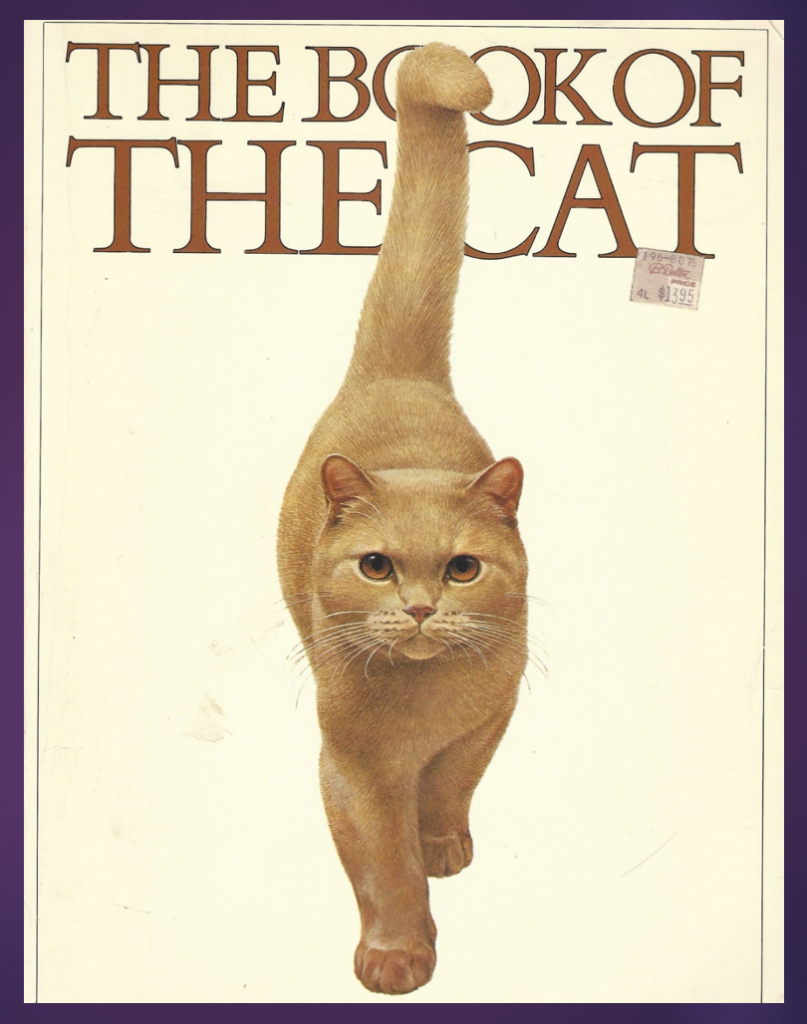
To assist us, in writing the Breed Standard for the American Curl, Jean introduced us to a book, called The Book of The Cat (now out of print). In the early 1980’s this volume was considered the most accurate text available presenting a short biography of each recognized breed with detailed drawings, some photos, a section on coat and color genetics, and basic cat care information.
Jean Grimm was the first to explain to us that each breed has, five or six key words, and/or phrases, that describe the CORE IDENTITY of every recognized breed.
Here are a few of the original pages, from The Book of The Cat with visuals and/or vocabulary words we borrowed from a few of the breeds’ descriptions in that volume.

We highlighted terminology from the following breeds:
Turkish Angora
Somali
Abyssinian
Havana Brown
Egyptian Mau
Ocicat
Tonkinese
———————————————————–
We processed through these “breeds of interest” and the terminology they used, to describe themselves, and realized all of them were known for their color and/or pattern.
We soon decided that the Egyptian Mau, and Ocicat, didn’t really share core similarities with the American Curl other than being in this ‘no-man’s land’ of not being like an American Shorthair or a Siamese.
We all collectively agreed, that physically, we had the most similarity to the Turkish Angora.

But we borrowed selected terminology from some of these highlighted breeds, (Angora, Havana Brown), or used parts of their vocabulary (Abyssinian, Somali) as the inspiration to create our own distinctive descriptions, and integrated these otherwise separate terms into our unique American Curl Standard.
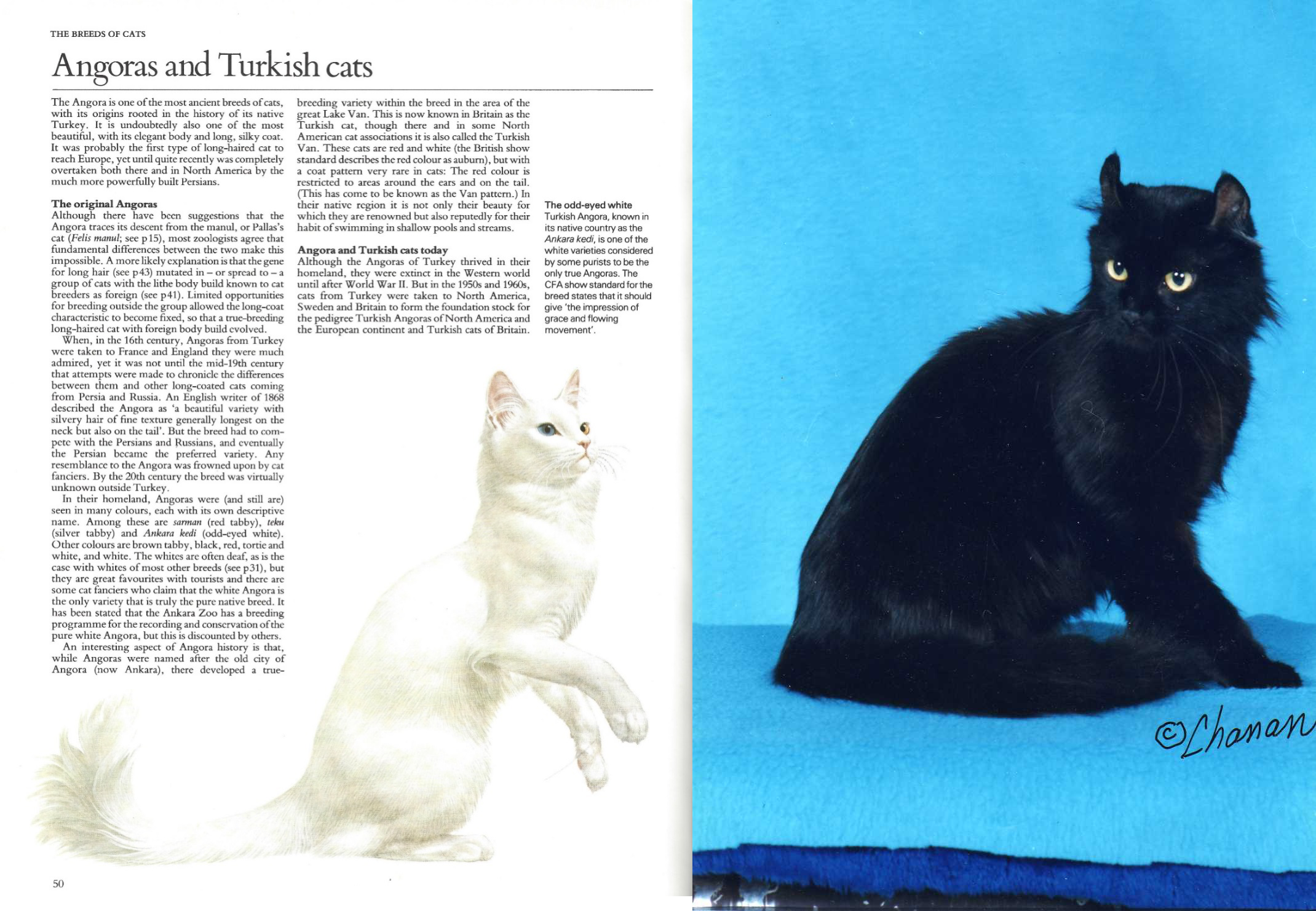 Turkish Angora page of Book of The Cat Shulamith
Turkish Angora page of Book of The Cat Shulamith
We all collectively agreed we had the most in common with the Turkish Angora
Over all, presentation, longer head, large ears, boning, size longhair, but less undercoat.
Our differences were:
Curls had a distinctly different ear set.
The Curl profile was VERY different.
The Curls had a shorter hair shaft on the body coat, giving us a “semi-long” body coat, and a longer tail coat, but texture was still ‘silky’.
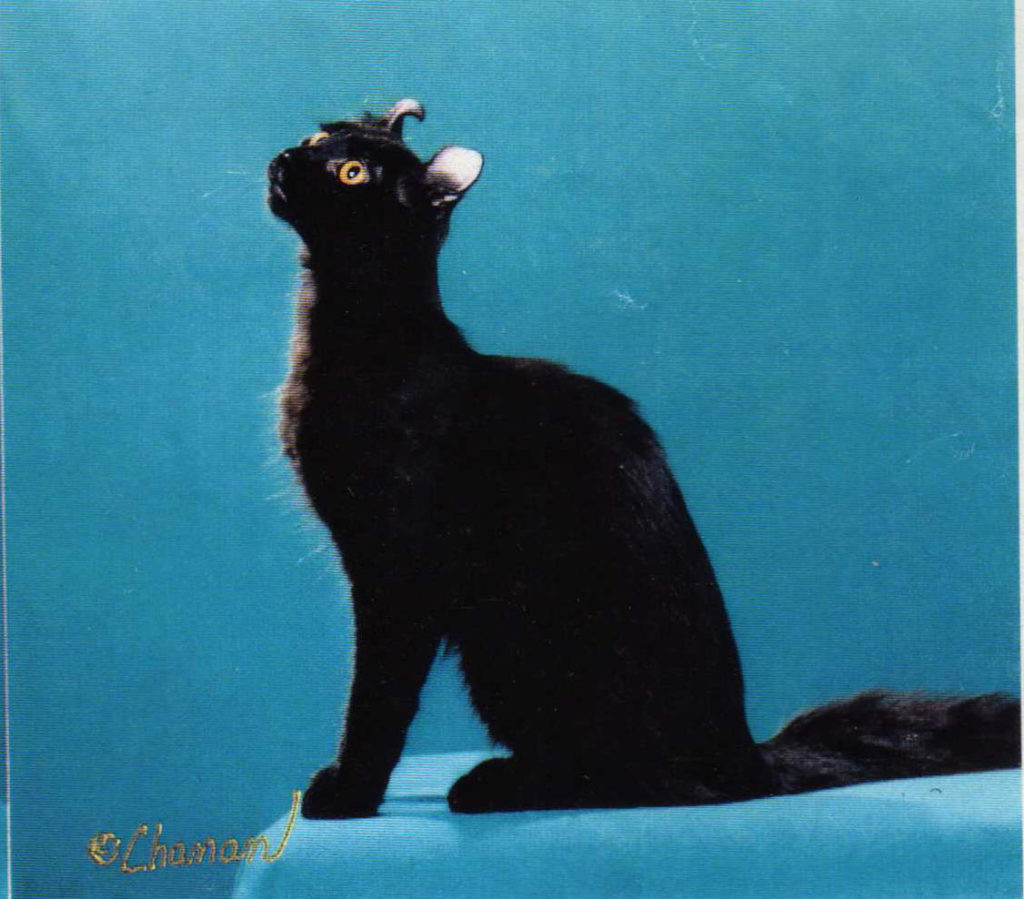
These became THE CORE IDENTITY WORDS for American Curl SIZE and STRUCTURE.
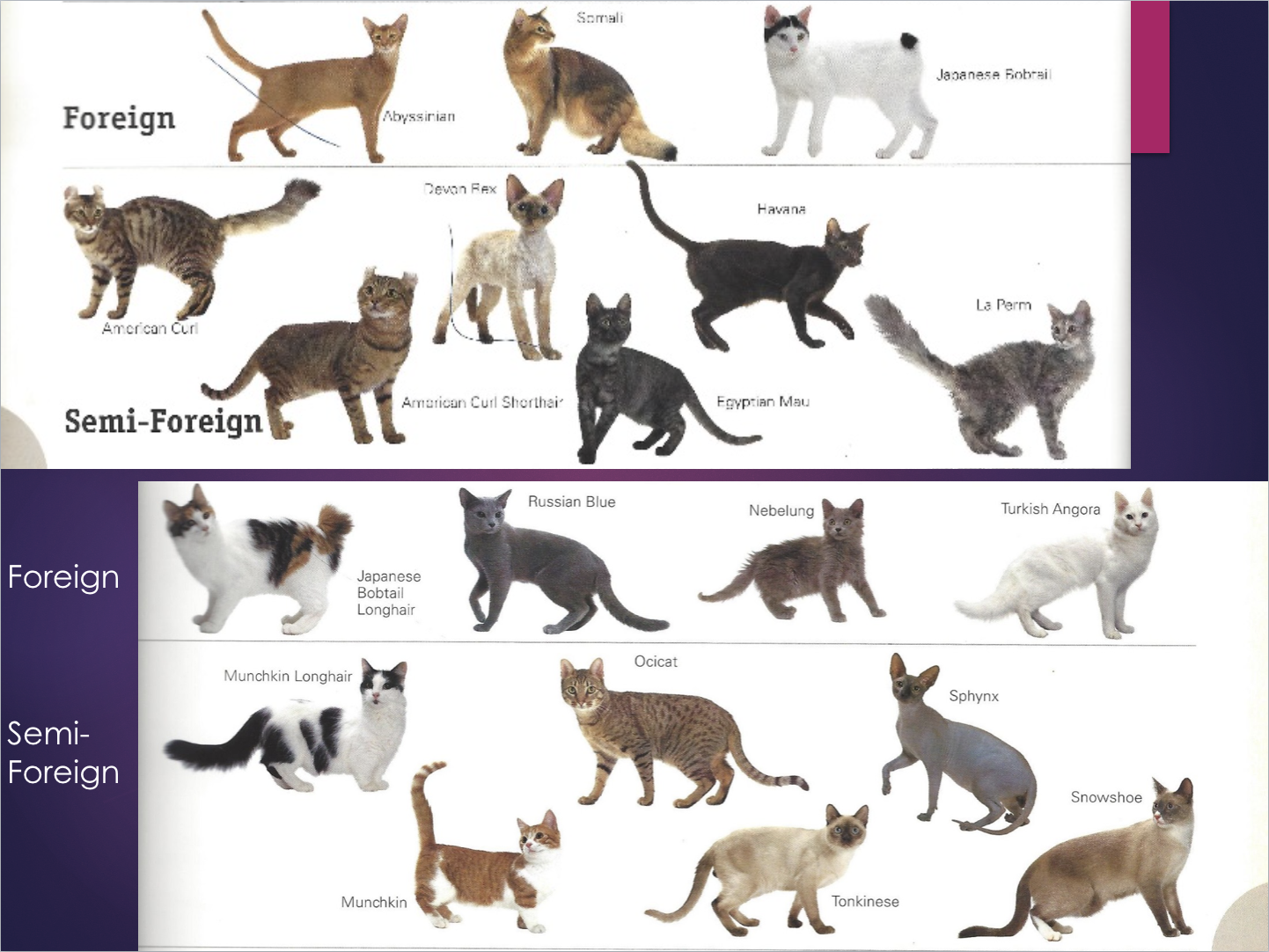
Taken from The Legacy of The Cat By: Gloria Stephens
+You will notice none of the breeds we borrowed language from, were cobby, in any way, or at the other extreme, large, with any dense, long, or double coats.
For decades, I have had pages from The Book of The Cat for the American Shorthair, Maine Coon, and Norwegian Forest cat all labeled “NOT THIS” in my Educational Notebook.
As we interacted with the judges, showing Curls in the New Breed and Color Classes in ACA- the American Cat Association, UCF- United Cat Federation, and TICA- The International Cat Association, without fail every judge in each of those Associations who handled Shulamith, evaluated her as “ a Turkish Angora style cat with — “weird ears”.
This confirmed our own assessments and breed comparisons and gave us great confidence in writing the American Curl Standard using Shulamith, as the structural prototype, and emphasizing that the American Curl Standard is written from the female perspective.
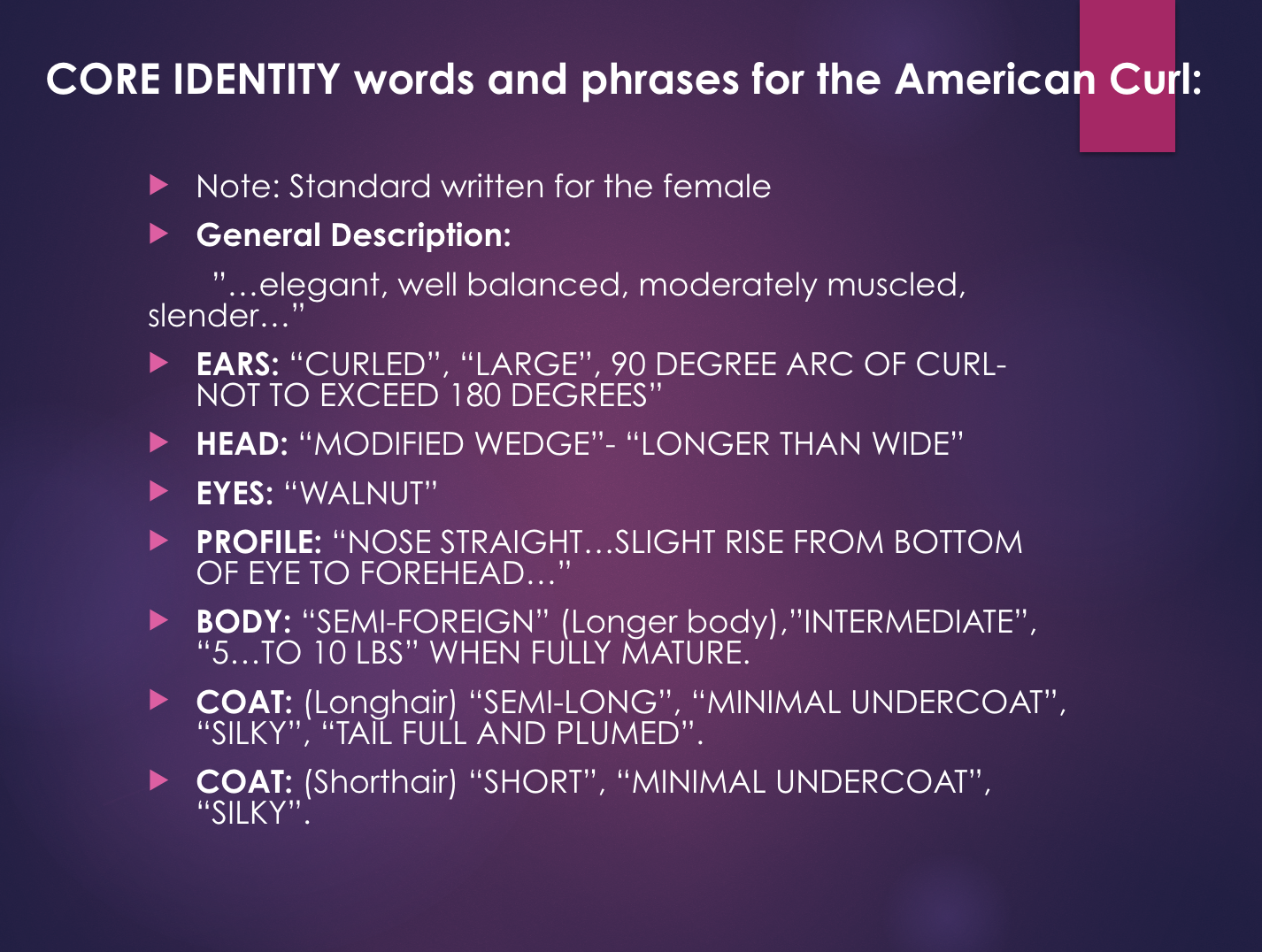
CORE IDENTITY:

From general description: “elegant…”slender”
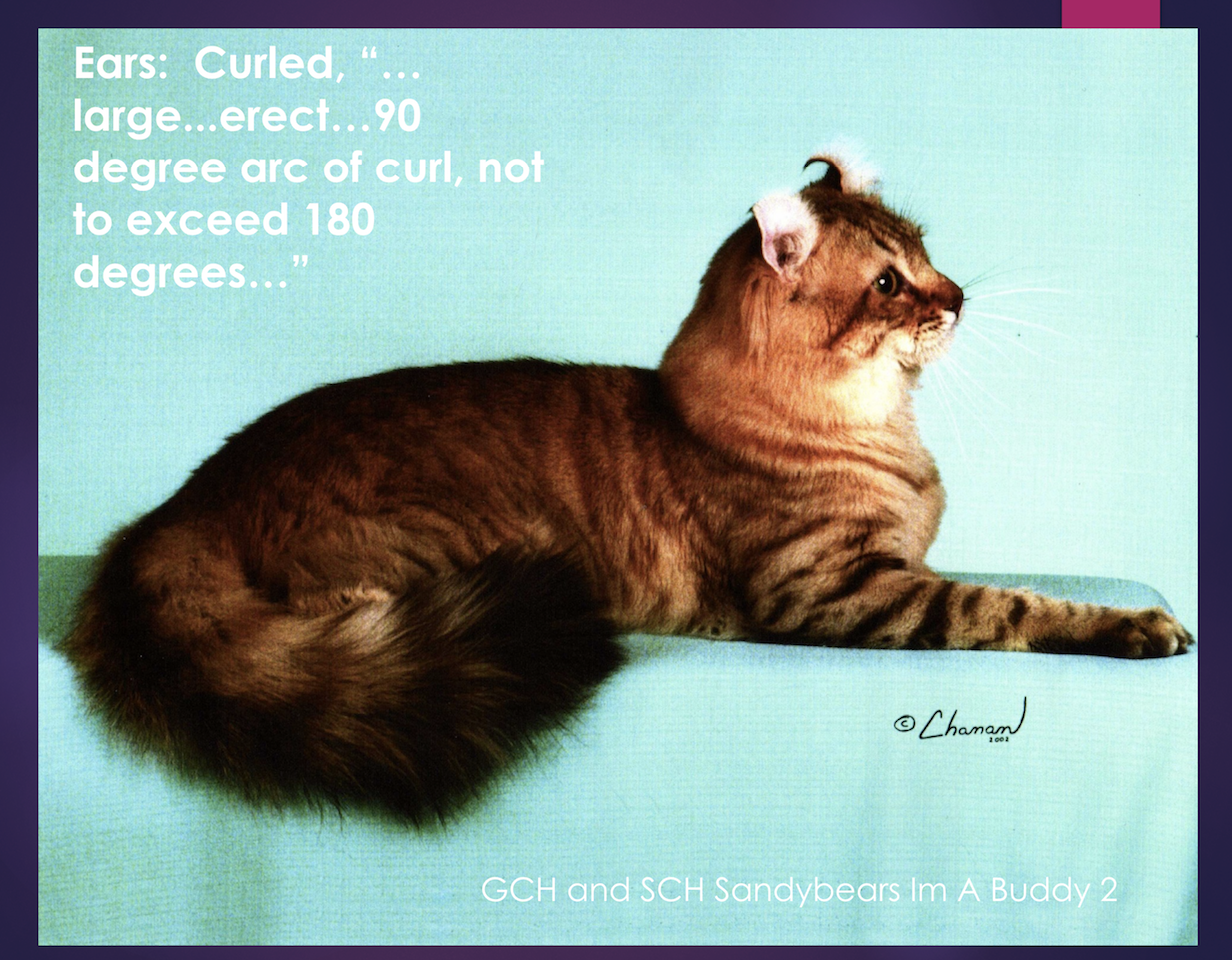
(displays textbook ear curvature for close to 180 degrees.
Body coat ratio to Tail coat nice also. One of first American Curls to title in TICA and then CFA) +++Only cat I will state titles on, because he set historical precedence for the entire breed.)
Ears: “Curled”, “Large”, 90 degree arc of curl-not to exceed 180 degrees”
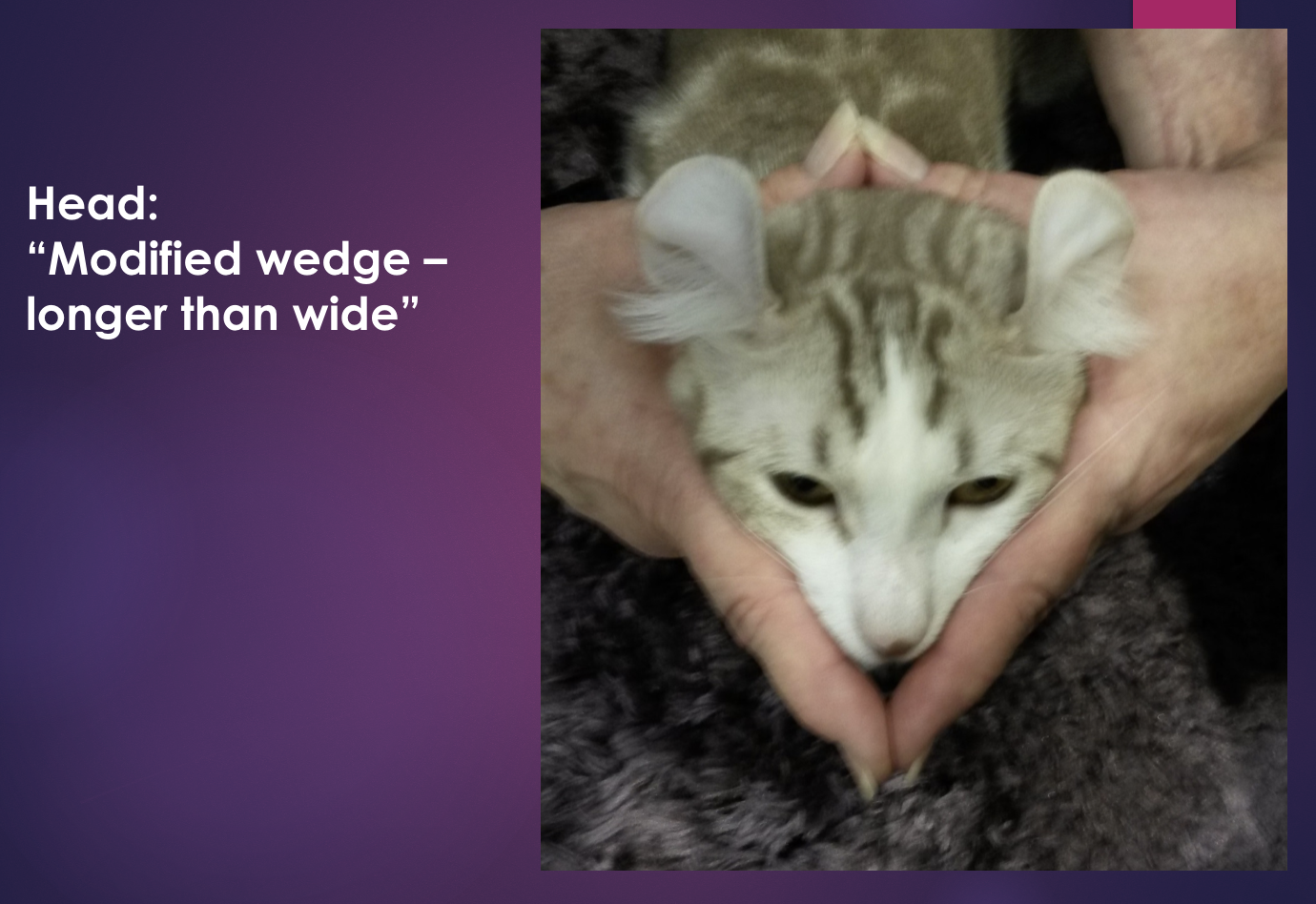
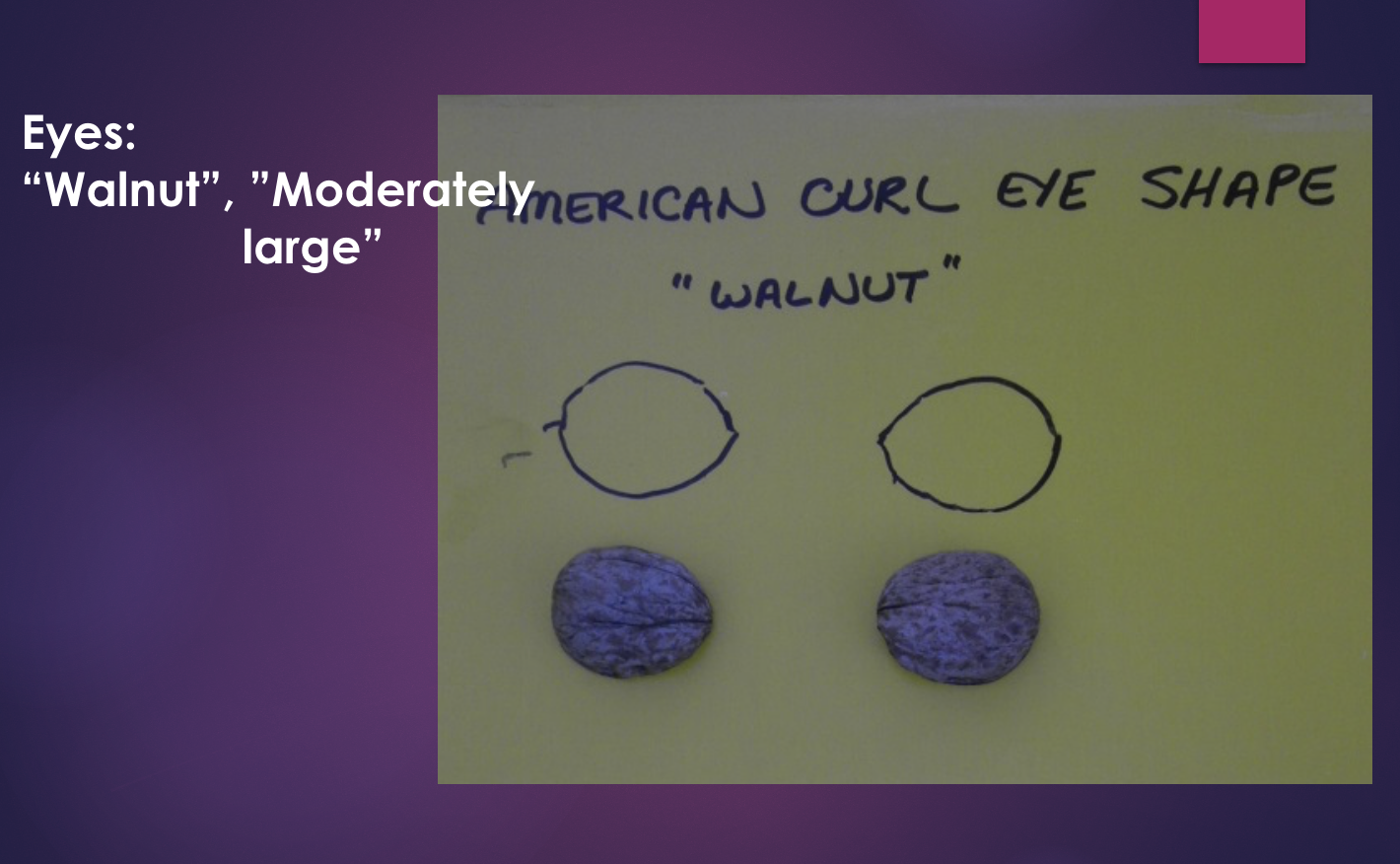
Eyes: “Walnut”, “moderately large”
Please note Eye Shape, Eye Size, and Eye Placement are three very distinct parts of our description. “Eye Size: Moderately large”. Very large eyes are not desired in the American Curl, too large an eye distracts from the breed identity. Small eyes and extraordinarily large eyes are equally incorrect.
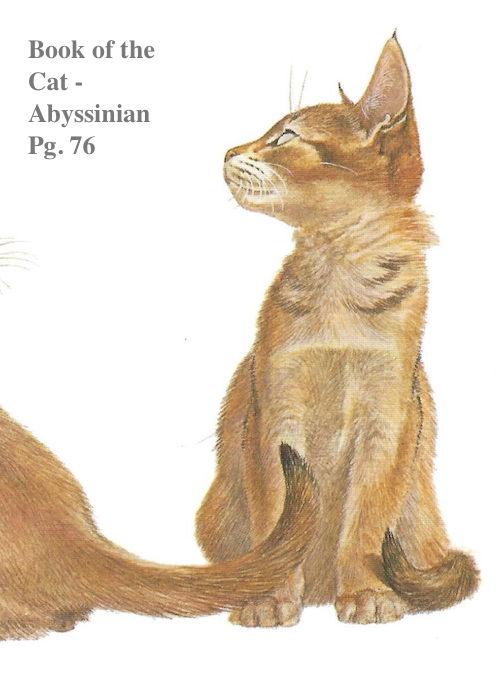
This drawing is the inspiration for the American Curl profile.

Profile: “Nose straight…slight rise from bottom of eye to forehead, gentle curve to top of head…”
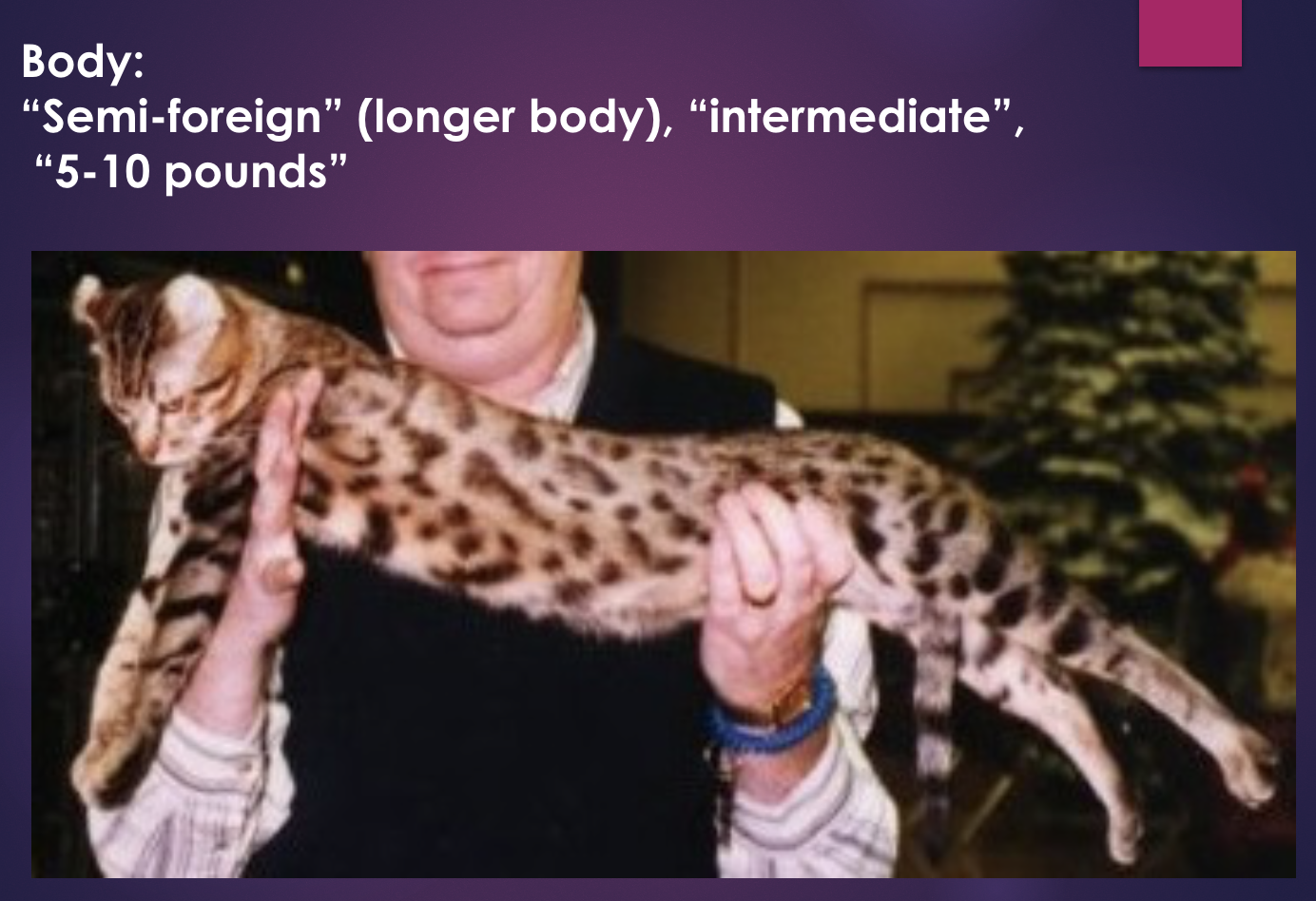
Body: “semi-foreign” (longer body), “Intermediate”, “5-10 pounds”.
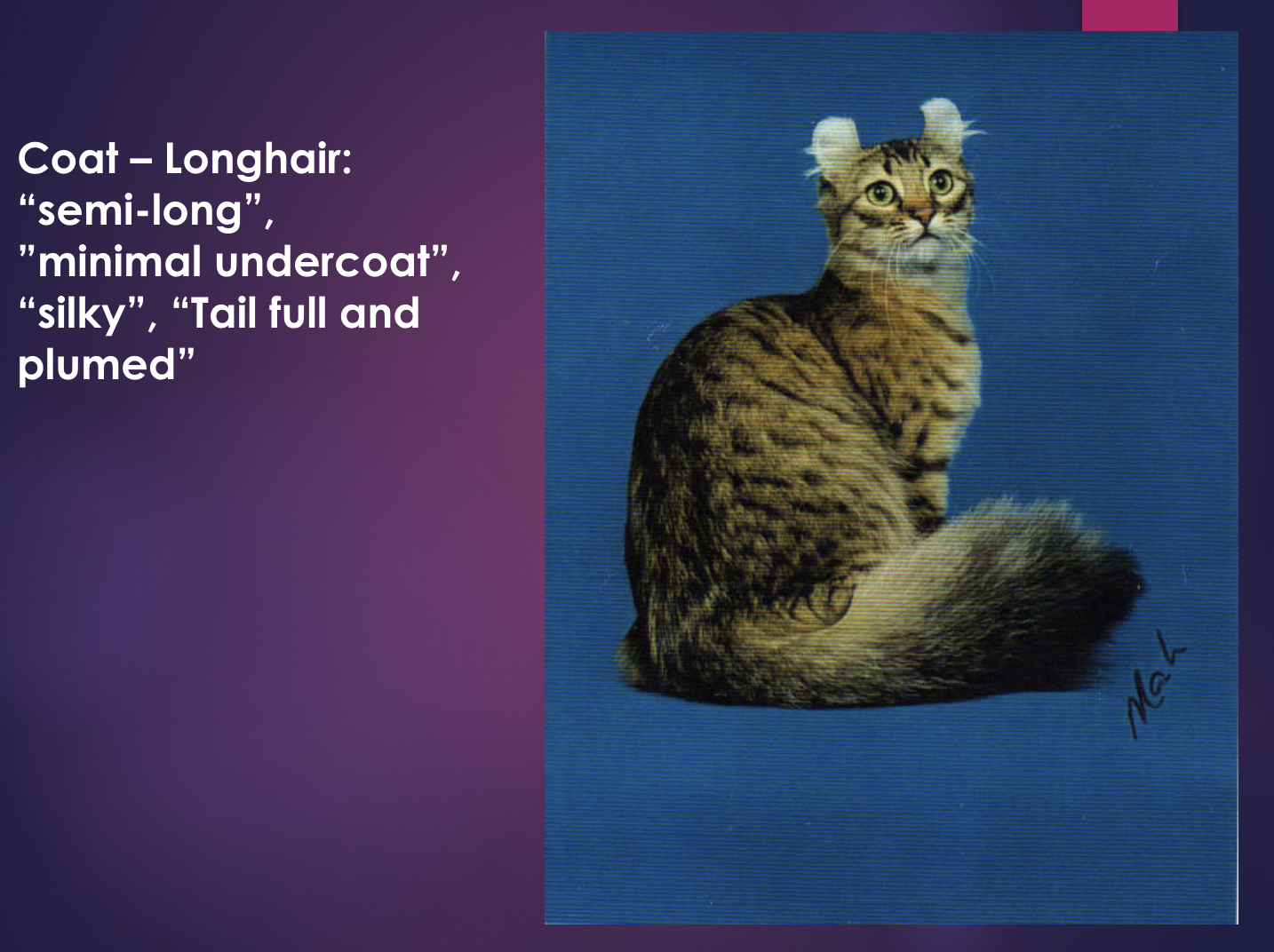
Coat: (longhair) “semi-long”, “minimal undercoat”, “silky”, “Tail full and plumed”
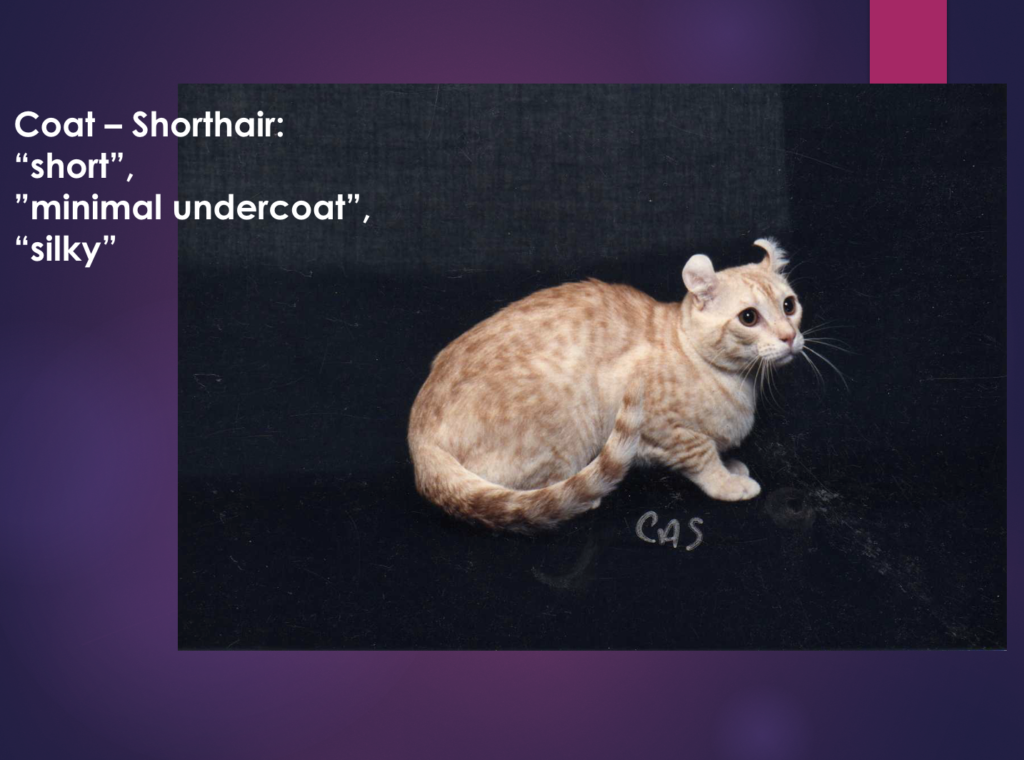
Here in the United States, TICA and CFA are the largest Associations. (Basically the same breeders were getting the Curls out to the shows of both associations, so when the Curls went before the CFA Board seeking registration, since we were already accepted in TICA, we just took the American Curl TICA Standard, changed the heading to read CFA American Curl Standard, submitted it. CFA, accepted it. Thankfully!) So for a period of time both associations had identical vocabulary describing the American Curl.
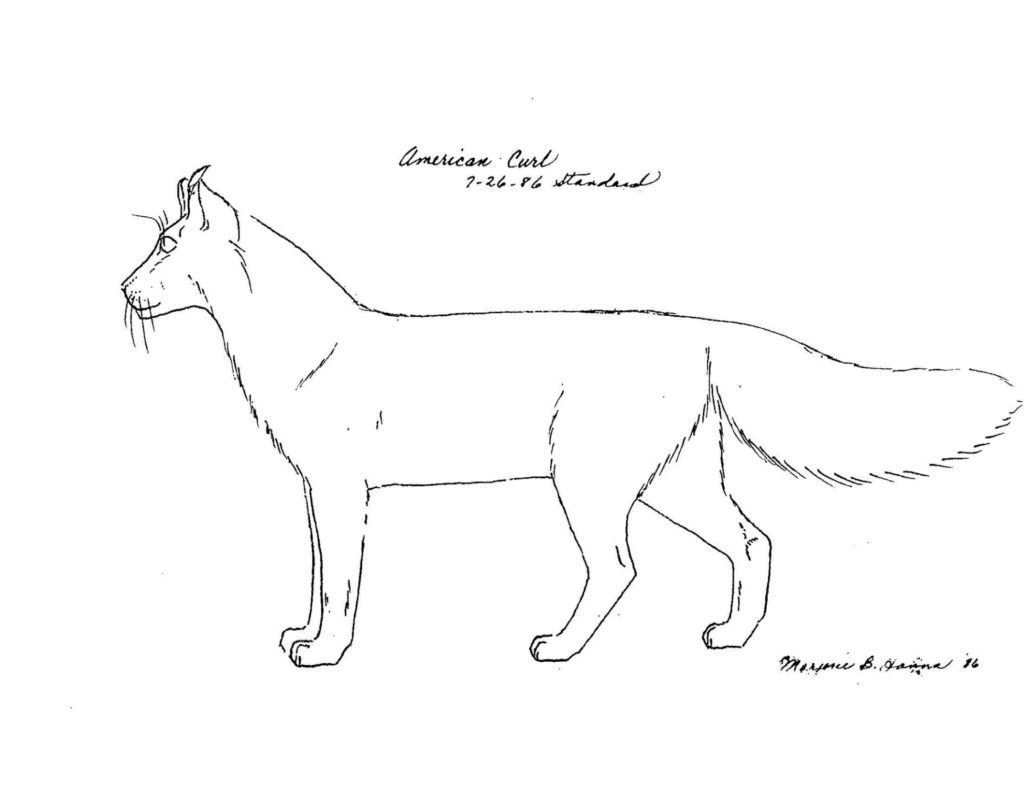 Slide of Marge Hanna Drawings.
Slide of Marge Hanna Drawings.
The first educational drawings for the American Curl were done by TICA judge Marge Hanna. She drew the cat by reading the TICA American Curl Standard, having never actually seen an American Curl cat!

Joe & I were presenting the American Curl to a TICA judging school in1986. When we brought out a white 6 month old Curl, we were startled when the participants asked if the kitten was the model for the drawings.

1986 Marge Hanna Drawings
We were impressed! We hadn’t known of the drawings, until then but were able to provide input for some corrections (primarily head shape and ear curvature rather than an abrupt bend).

corrected 1987 Marge drawing.
Marge Hanna obviously understood the “semi-foreign body” style, with a “semi-long” flat coat, and “plumed tail”, with a longer head accurately, just from the written vocabulary words we had used.
Over the years a variety of drawings have been done. These are mine from 1997. I do not make any claims of being an artist!
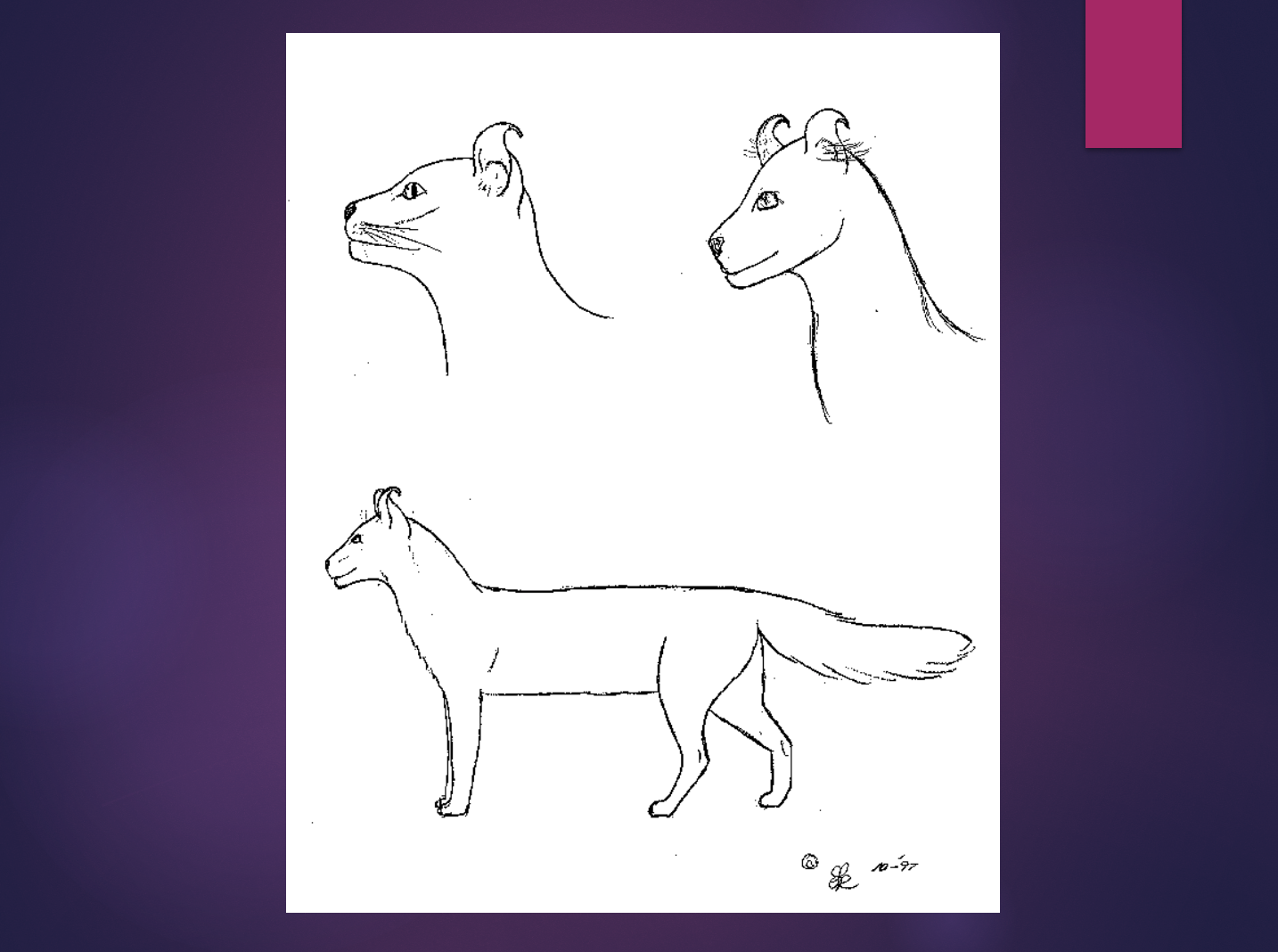
G Ruga drawings from 1997
GENETICS/OUTCROSSES
As we launched this project, of developing a new breed with very specific expectations and guidelines (with two very small children and almost no funds)
Joe and I leaned heavily on the recommendations of such personalities, as world renowned genetist, Dr. Roy Robinson, Dr. Solveig Phfluger, also a known genetist (if you read Journal of Heredity).
Gloria Stephens, Judging Administrator for TICA, at the time (later author of Legacy of The Cat), helped me with vocabulary and definitions.
These are just several among others who mentored us in the crazy new world of the Cat Fancy we found ourselves in.
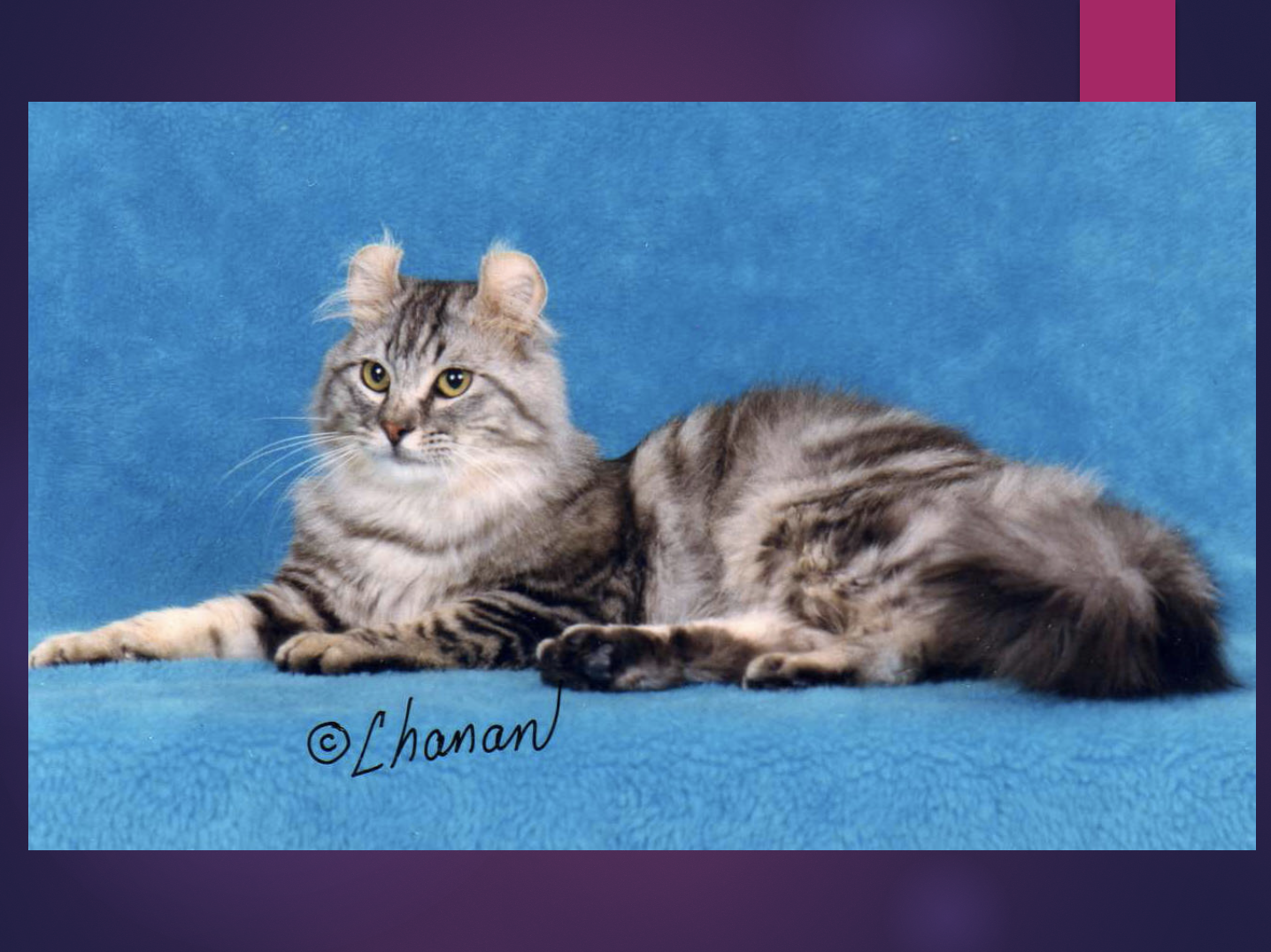
Having been given instructions to “choose’ a recognized breed to use as our ‘outcross’ gene pool to develop the American Curl, we came to realize that either temperament, color identity, medical issues, or a very small gene pool were prohibitive to our using a ‘recognized breed’ to develop the American Curl as its own entity.
Physically we were closest in structure, body style and coat to the Turkish Angora. But in the 1980’s the Turkish Angora had a very small gene pool, most cats were white, and very few were available.
The American Curl, originating in the domestic cat population had a broad color spectrum which we had neither desire nor reason to limit, since our Distinctive identity trait was structural.
Our goal was to have as healthy a breed as possible. A lot of inbreeding, was not a logical choice to us as we saw the evidence of the issues other established and younger breeds were having, because of the insistence of inbreeding to achieve ‘type’ quickly.
We came to the conclusion that ‘none of the above’ were our identity…so we made the first of several decisions that came to influence the entire Cat Fancy.
We made the decision to return to the Domestic cat population for our ‘official’ outcrosses.
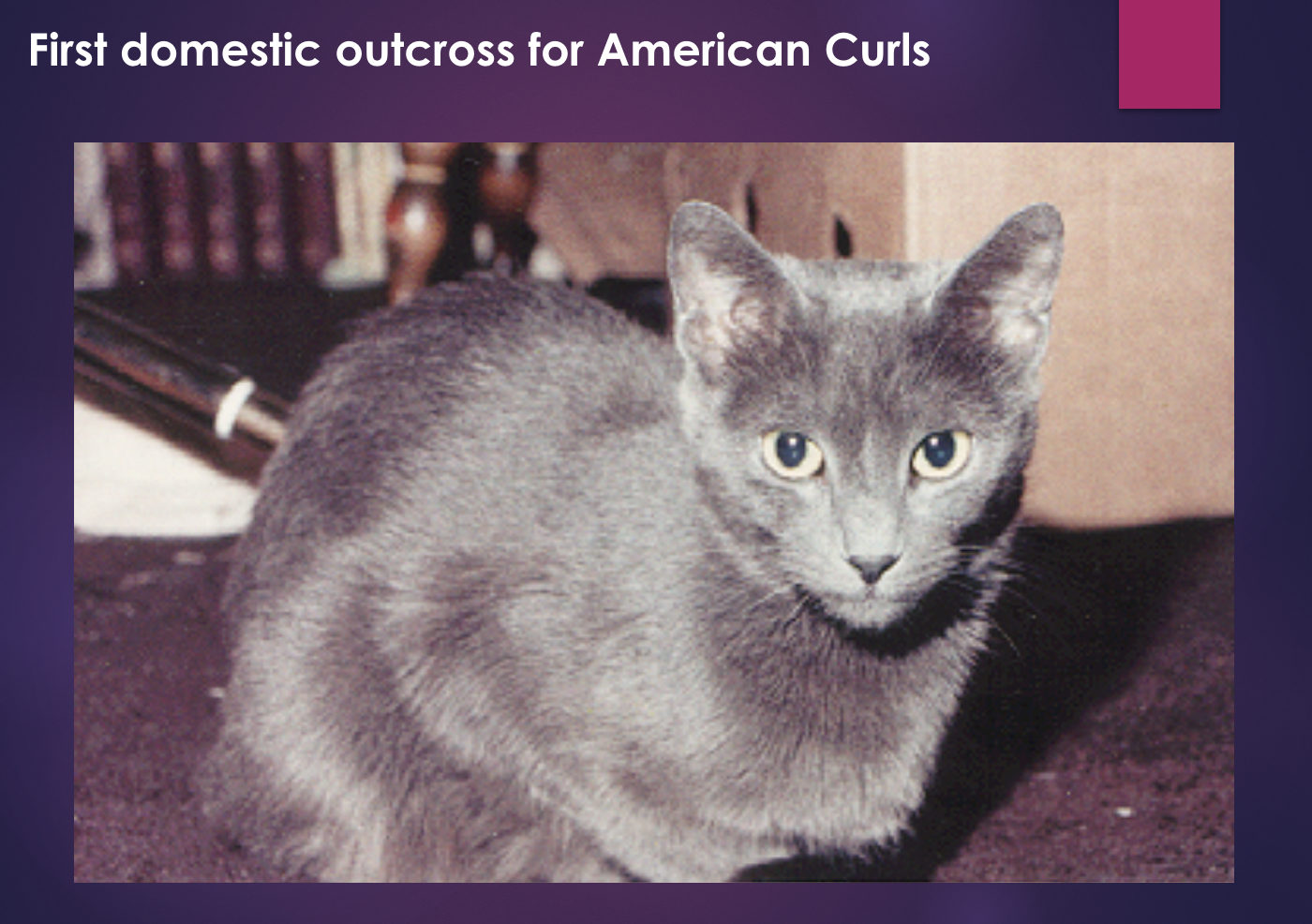
We began to search for domestics wherever we could find them, with a very specific “modified wedge” head shape, distinctly “longer than wide”, a unique profile, large ears, “semi-foreign” structure and boning, not over 10 pounds, with a “semi-long” coat. They were not easy to find!
A SH blue named Vashti was our first chosen Domestic Outcross. To this day, if I could find another like her, I would include her in my current breeding program. (although CFA closed the domestic open registry for American Curls in 2015)
Dr. Roy Robinson and Dr. Solveig Phfluger in particular, were two individuals who affirmed us, that our perspective of very limited inbreeding was valid and we could retain the structural identity we were already displaying and improve upon it, building and maintaining our genetic health at the same time.
They laid out for us the importance of NOT using any cats in the breeding program that had traits that could be genetically passed and permanently set, becoming negative or detrimental to the breed at any time in the future. Anything that was questionable, should NOT be bred at all rather than included in the breeding program and become a serious genetic issue years later. This was a rare opportunity! We paid particular attention to any ear types that were unappealing or seemed ‘deformed’ in any way.
As these evidenced and were identified, they were added to Penalize or Disqualify in the American Curl Standard.
****slide of pinched ears — pinched ears,
*****slide of small ears — small ears,
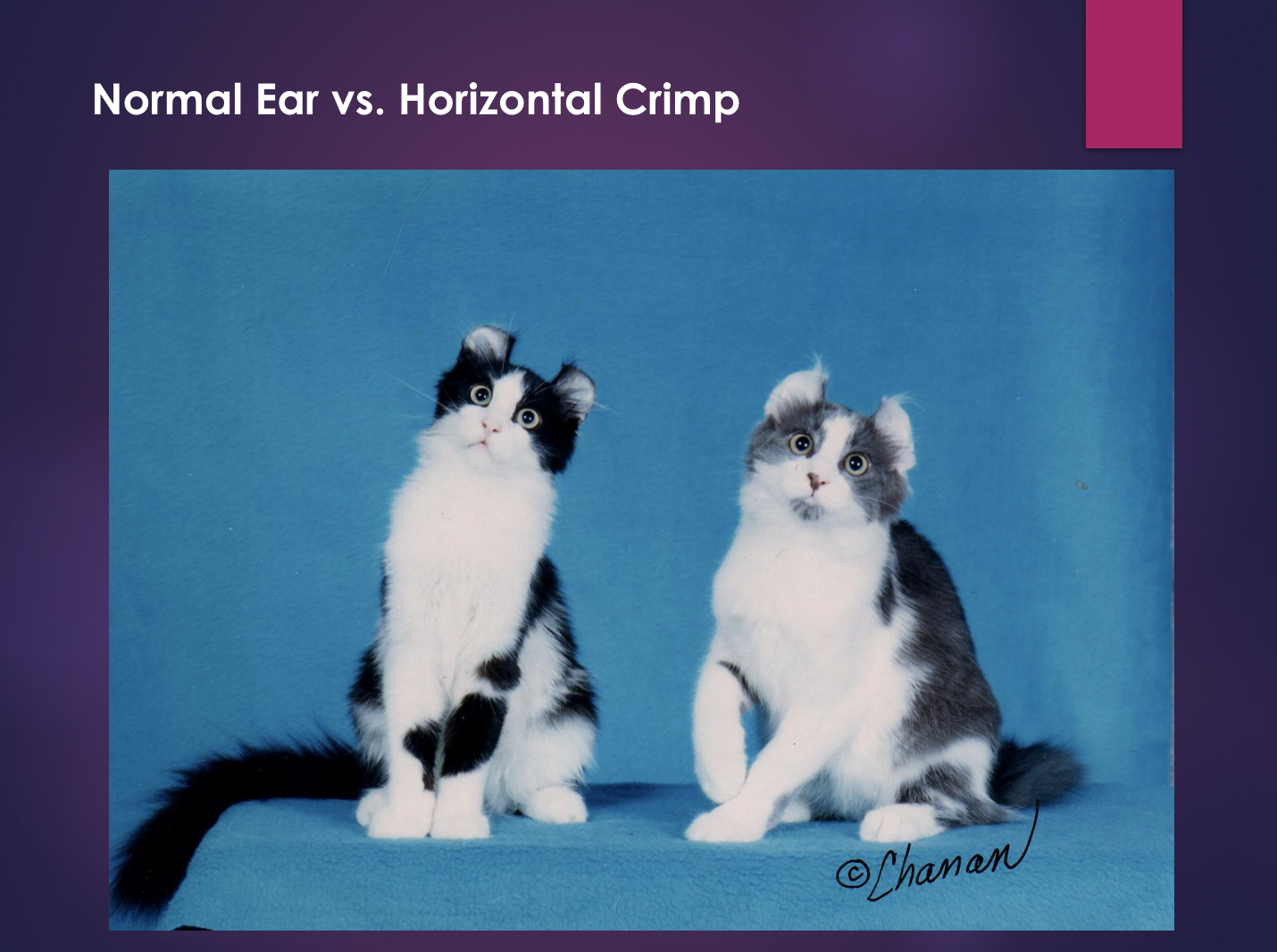
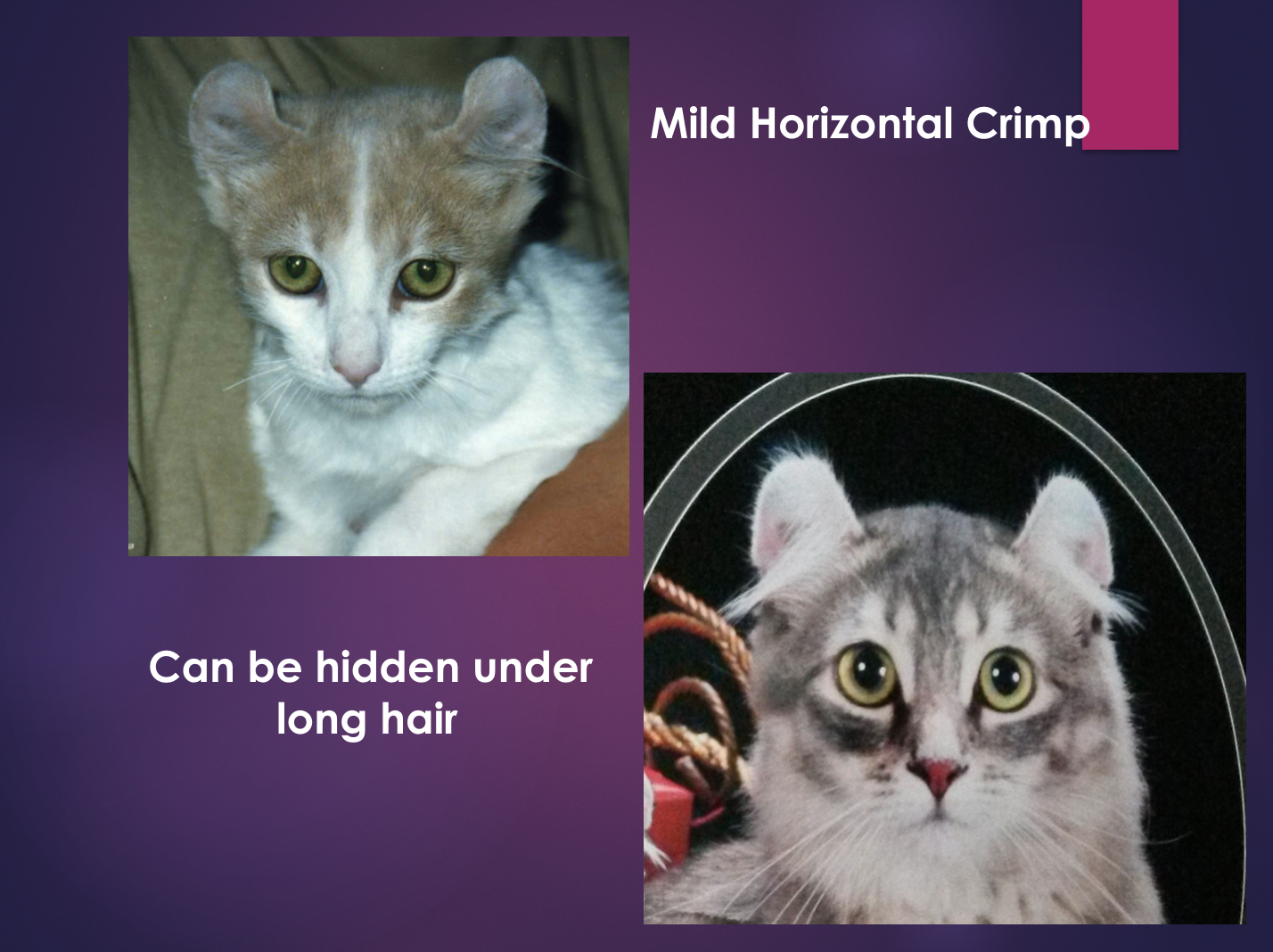
ALL Horizontal Crimps
Horizontal Crimps evidence from severe to mild that cannot not be seen in long hair)
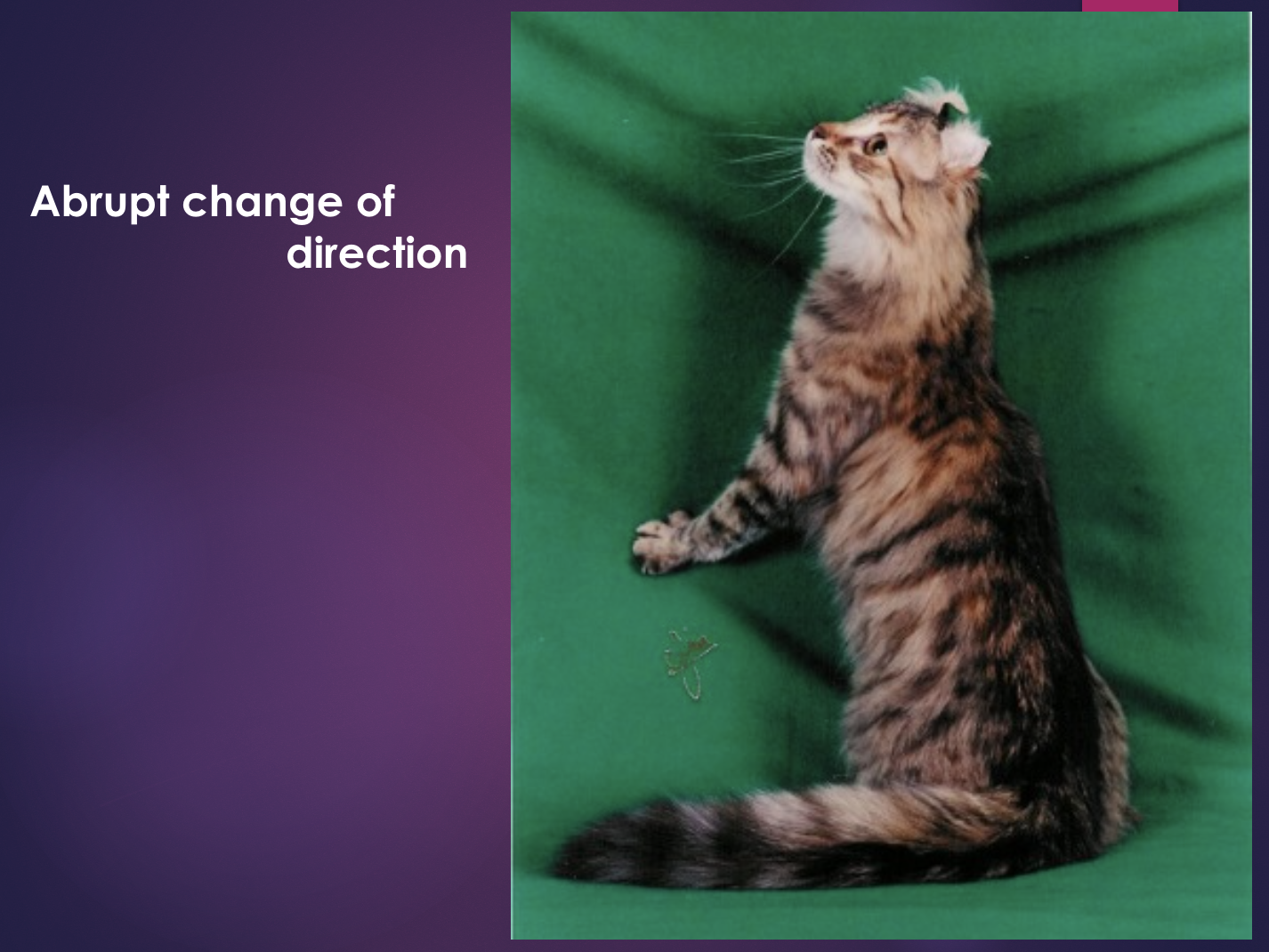
These are both variations of abrupt changes of direction.
Which can be pretty much anything other than a “smooth arc” that follows the curvature of a coin approximately 2 cm across”
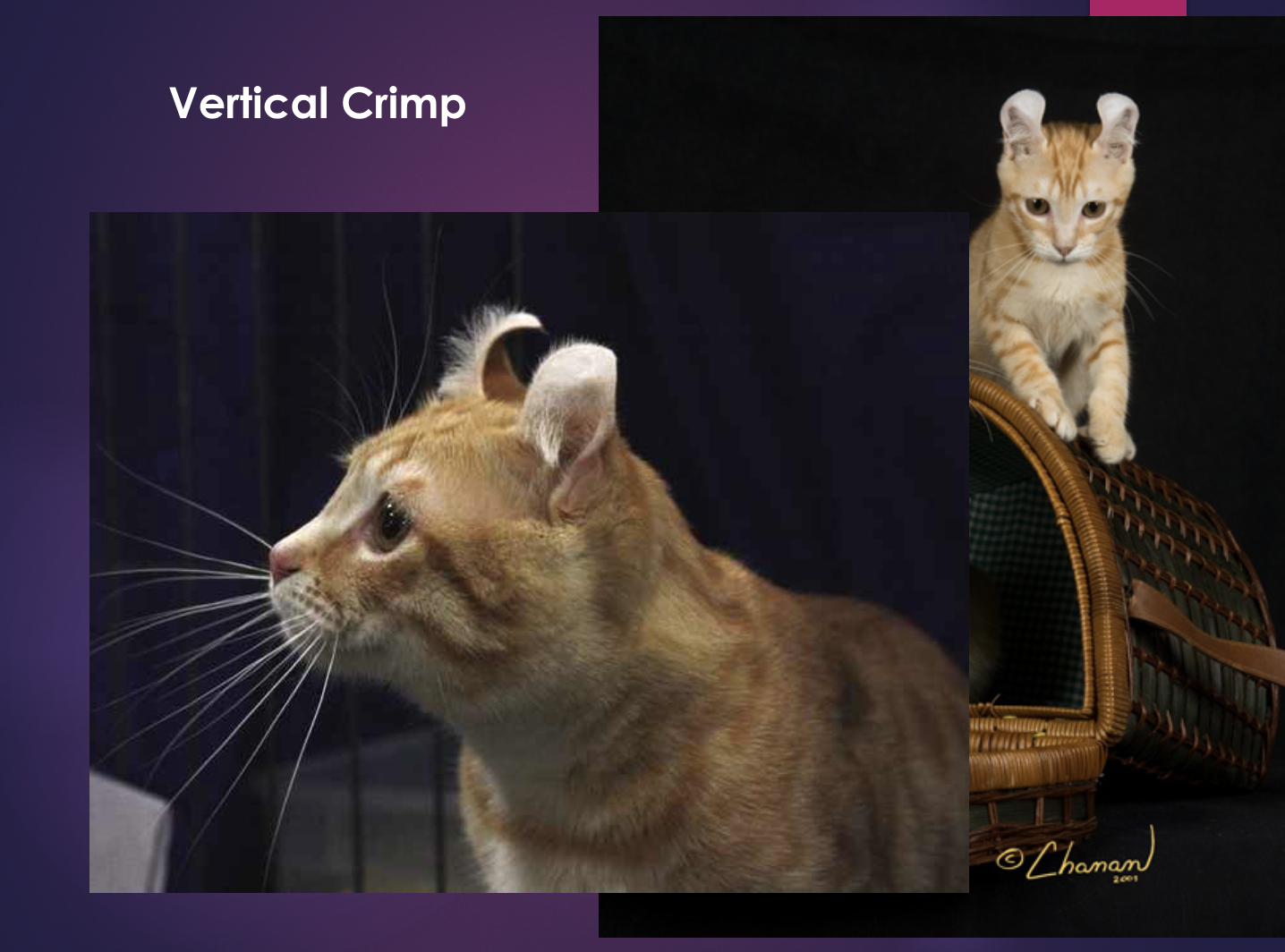
Which can be hidden in longhair. The base of the ear appears as if someone tried to bring the outer edge of the ear forward and pinch the ear opening closed.
Corrugated ears are also a penalty trait, that must be felt.
Thick ears (listed in DQ) are rarely visible in a photo, and must be felt to identify. The cartilage in a normal Curl ear is hardly thicker than a regular straight ear cat. It just feels different. So a ‘thick’ ear is very evident.
…were all added to Penalize or Disqualify Listings in the American Curl Breed Standard.
Although tight ear canals would be considered a DQ fault, tight ear canals were never on the DQ Listing because it wasn’t possible for a judge to identify them. Tight ear canals do not allow for adequate air flow, and ear infections can occur. In some instances it becomes an issue as the cat ages into its senior years.
However, breeders were instructed not to breed any Curled cat that a regular size cotton swab (Q-Tip) couldn’t fit into the ear canal for cleaning by age 4 months. These were/ are all undesirable traits in the cartilage.
==I personally will not breed a cat with tight ear canals no matter how excellent the cat is otherwise. Penalty: HC ears (no matter how mild), ‘Thick’ ears which are a DQ, and tight ear canals are all as serious and undesired in my house as any tail fault.
Anything to do with cartilage changes was carefully observed because we were still looking to confirm, there was no negative genetic attachment to the desired ear presentation, and that there was no influence on the cartilage throughout the entire body, as other breeds have experienced. (**Note – to date there is no negative attachment.)
Joe and I did each breeding with the conscious thought that the decisions we made today, could be a blessing or a curse to another breeder in 20 years.
As you all know, not every breeder will hold the same high standards when there is a competition to be won!
Despite our best efforts, ALL of these traits are now firmly entrenched in the genetics of the American Curl worldwide.
As most of you are aware, the breeding program to develop a breed is quite different from the breeding program of an established breed, the Curls seemed to attract a lot of other novices to their breeding program.
And over the years, with more enthusiasm than wisdom, changes were made to the American Curl Standard in different ways which inadvertently changed the structural direction of the entire breed!
These inexperienced breeders decided it was easier to change the standard than make difficult breeding decisions that aligned the cats they had, to be closer to what the Standard already described and required!
Some procedural changes were made, in how judges were instructed to evaluate the ears. Some Penalty traits were removed, and some Disqualify traits were either removed or downgraded to Penalize, as some judges began to question specific traits of some particular individual’s cats. (As far as I am aware those who enacted the changes have not been active in the Curls for years.)
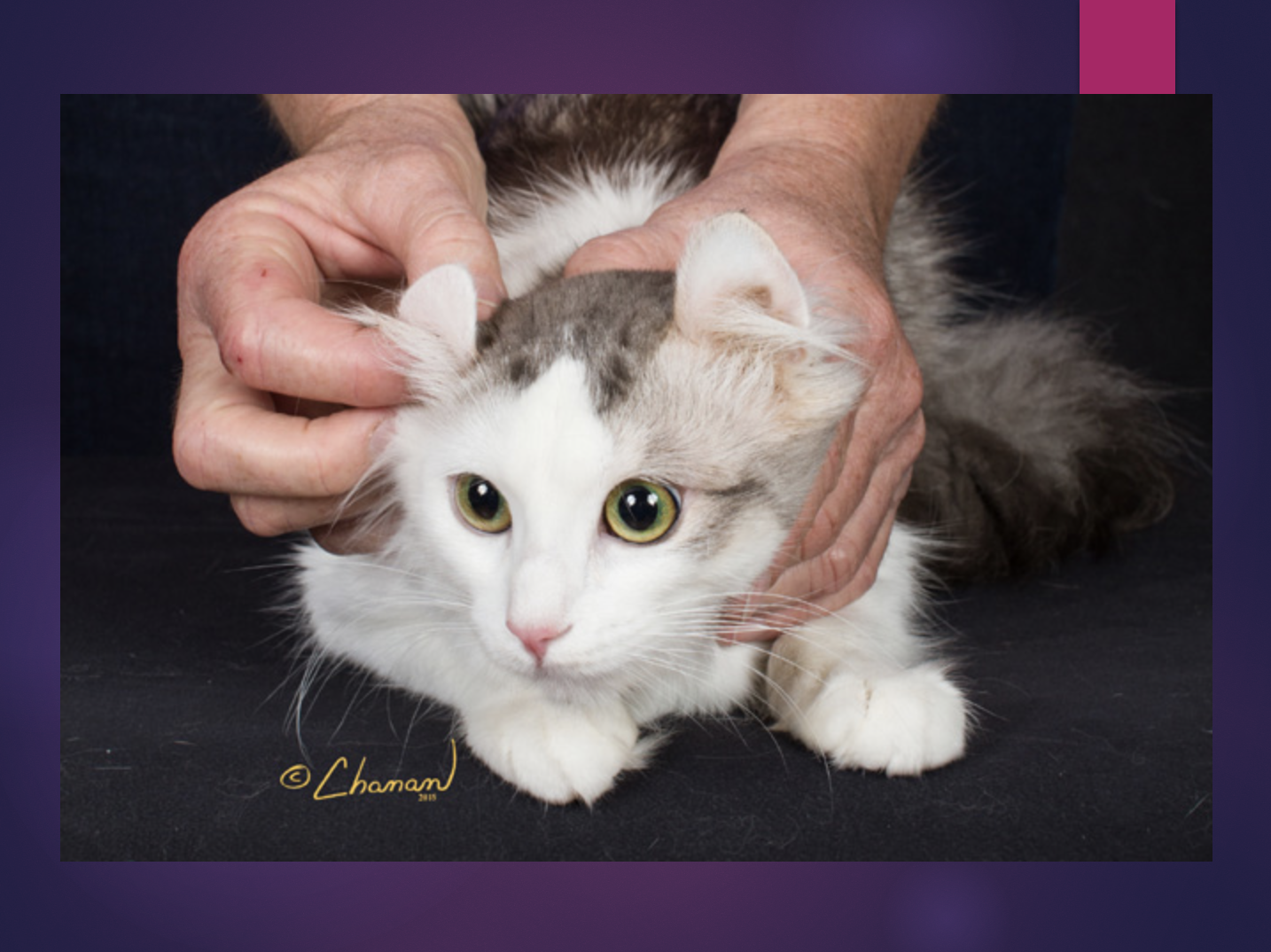
After years of judges handling the ears of American Curls on the judging table, to correctly identify several of the ear faults we just itemized…
Suddenly judges were told NOT to handle the ears of the American Curl because it could ‘disturb the cat’, or be ‘uncomfortable’, in some way.
It was a puzzle as we watched this rather abrupt change in evaluation, since it is very simple, and when done correctly, causes no discomfort at all.
***Red Long Hair (video)
Let me demonstrate… It takes a matter of seconds to learn everything needed, by simply letting the ear slip through thumb and forefinger, with no applied pressure, from ear base to tip. All American Curls, should find this kind of touch normal to their daily lives.
The ears can be easily rotated, by lightly moving them to have the tips point towards each other, to confirm being matched, again, no bending, no pinching, no pressure.
Specifically handling the ears of the American Curl, is essential to identify genetically negative traits particularly those listed in Penalize and Disqualify as we previously mentioned.
### – It was really brought to my attention in 2009.
I missed a major show in our region, because my father had passed away. Another breeder kindly agented my kittens for me. There was a large class of kittens. All of which had itemized ear faults. The judges pulled out their standards (good!), and made their choices…but they obviously didn’t connect the physical expression of each kitten, with the correct vocabulary words they were reading! Several wanted to DQ my SH kitten – he had unusually large ears (which he totally grew into) with textbook perfect curvature, and a Vertical Crimp. They actually considered withholding wins! If he had been a LH they would not have seen the VC. VC is a penalty trait. The LH kitten they consistently placed first, was very attractive but had “thick” ears, with a nice curvature. “Thick” ears are a DQ. None of the judges touched the base of any of the ears, so they never identified the correct traits.
I know of several highly awarded American Curls that according to the American Curl Standard at the time, should not have received their awards, with the listed Penalty or DQ traits they displayed, but were not identified by the judge because of this one change in handling procedure.
Current CFA American Curl Council Members, in their desire to restore the Core Identity of the American Curl wish to see this practice of appropriate and correct handling of the American Curl, re-established. These breeders do not think an American Curl has been evaluated by the written Breed Standard unless the ears are appropriately handled in this way. Michael Bull, our CFA Breed Council Secretary is available for further discussion on this as well.
Over the years, several Standard changes, impacted the American Curl in unexpected ways, causing the direction of the American Curl to veer away from its Core Identity.
One major change was to the TICA American Curl Standard:
The weight guidelines of “females 5-7 pounds, males 8-10 pounds” in the General Description, of the Standard were removed.
For some time, in the text of the body description the word ‘substance’ had been used (and retained) in an attempt to indicate neither ‘flabby’ nor, hard musculature was desired, but we wanted to feel some ‘substance’ in the context of a mature cat (3 years) not over 10 pounds, with a long body. As history has shown us, without the weight guidelines the word ‘substance’ was misapplied to mean, a ‘cat of substance’ as it is used in the broader context, as a larger cat, with weight. That is obviously outside the boundaries of our CORE IDENTITY trait of ‘5-10 pounds’ at full maturity.
(video)
The Standards, listed the phrases “Proportion and balance more important than size”, “allowance made for larger males” and “Allowances made for normal male characteristics.”
These ‘Allowances’ were originally intended to be removed when the Curls advanced to Championship Status in CFA. They were considered ‘interim’ allowances because there were so few American Curl cats available to be seen and handled.
It was reasoned by the time the Curls attained Championship Status in CFA , there would be more consistent ‘show quality’ American Curls around the world, within the weight guidelines listed in the General Description.
But instead, these “allowance” phrases were retained and became the ‘excuse’ many new breeders and exhibitors were instructed to use, as to why their larger cats of both genders were acceptable and not to be penalized (per Penalty listing of “Body: excessive size” which has always been in the American Curl Standard.)
*Please note, there has never been a penalty listed or desired for Curls that are smaller than listed weight requirements!
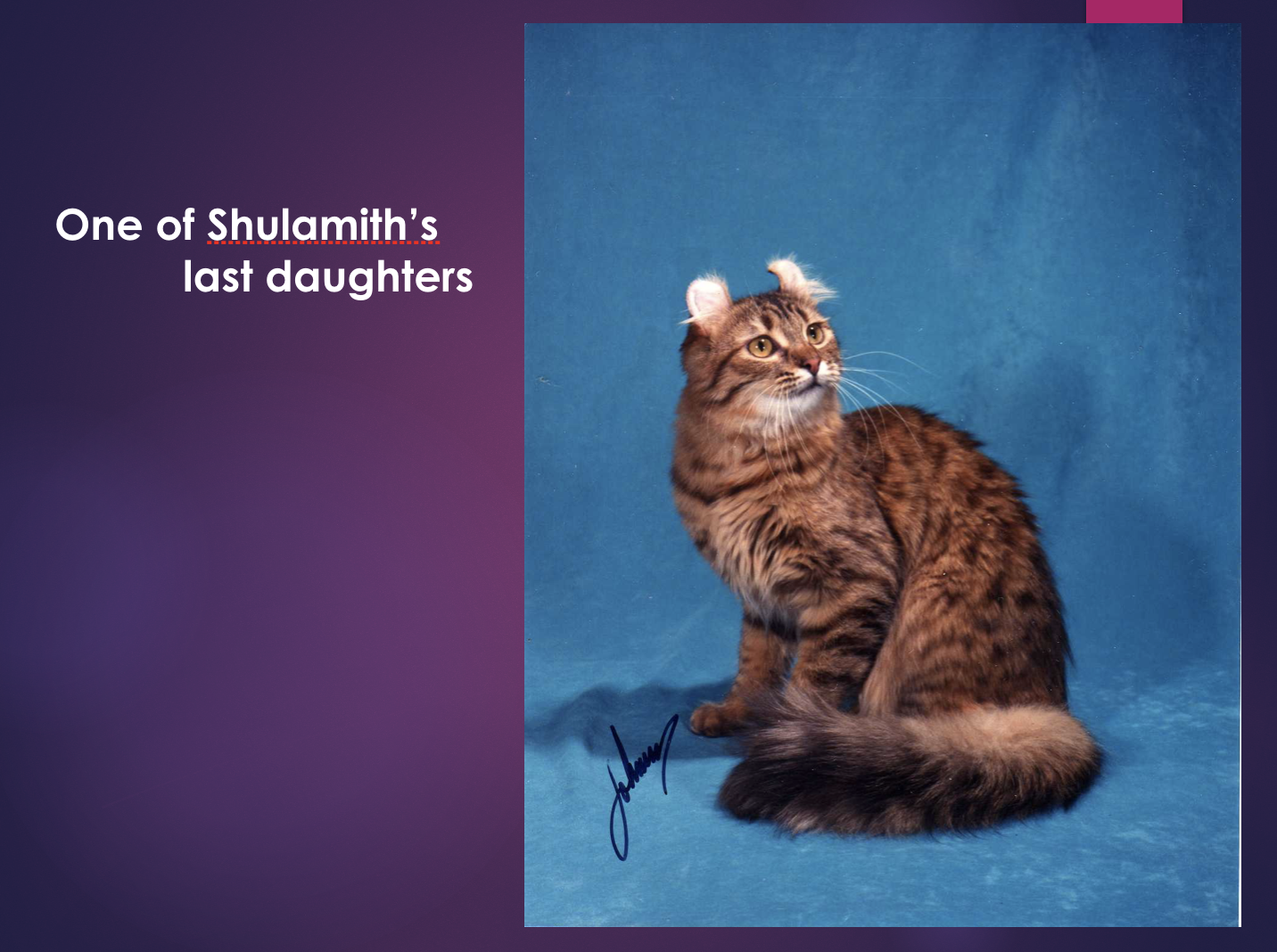
A number of years ago, a well-known and well respected American Curl breeder, when asked about correct Curl size and the use of the word “medium” would reply – “Curls are at the small end of the “medium” spectrum – just above Singapuras!” Singapuras as you all know are considered the smallest of the recognized breeds! We wholeheartedly agree with his assessment!
Another example of an un-intended re-direction of American Curl structure and form… the phrase “without flat planes” was added to the modified wedge head description. Solveig Phfluger, questioned how it was possible to have any kind of ‘wedge’ without some ‘straight lines/planes’? (A great question, I also would like an answer for!) In combination with that insertion…
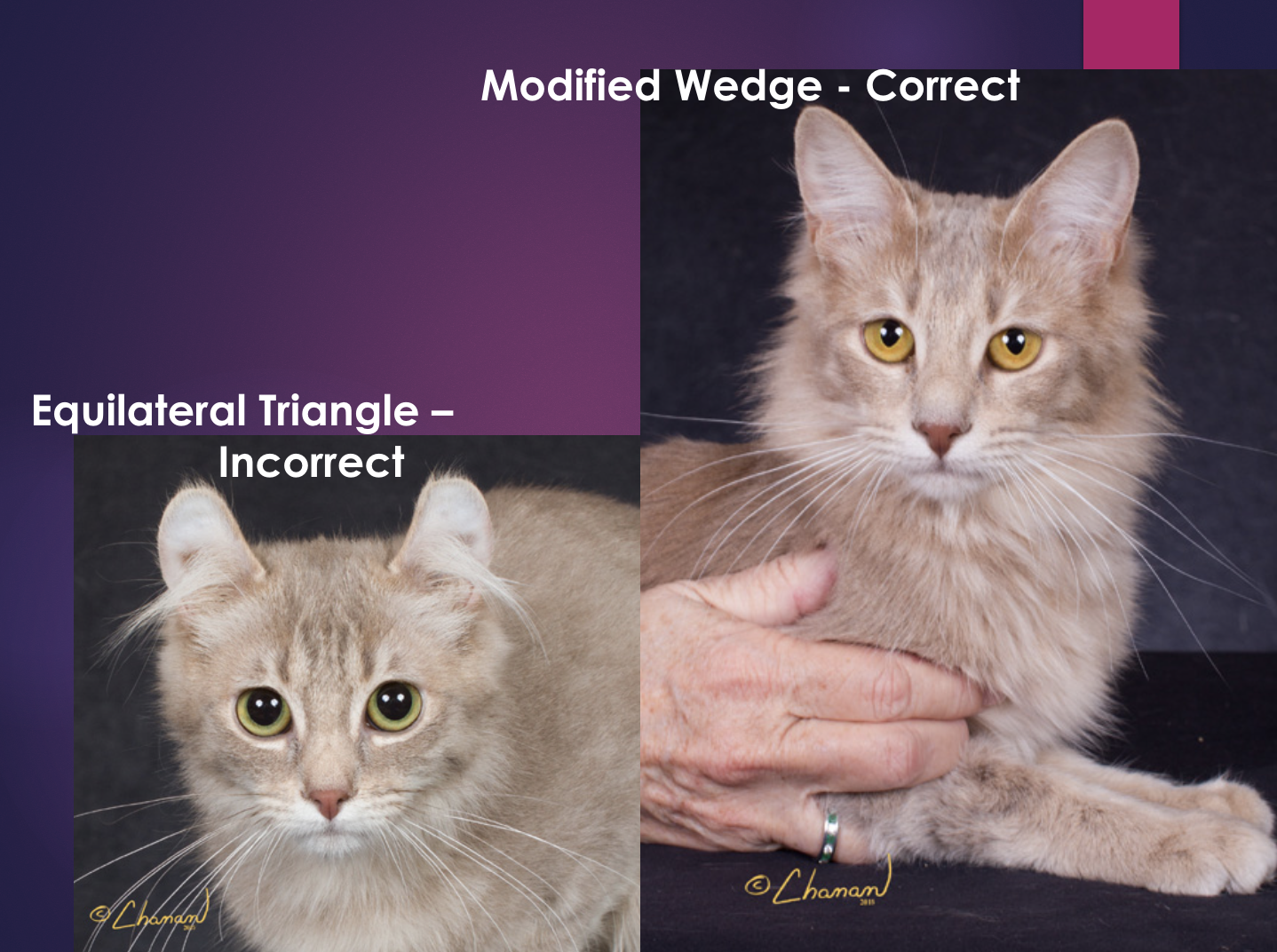
Correct and incorrect head shape – both lilacs are American Curls.
the “Muzzle” description was changed. CFA Standard originally read “Neither pointed nor square” since it was already understood that Curls as “semi-foreign, with a long body” needed to have a longer face than most other breeds, this phrase defined we did not want the extreme ‘pointy-ness’ of the Siamese or Oriental, nor did we desire the ‘square’ muzzle of the Maine Coon, both of whom have long heads. A ‘broad’ muzzle was not in the equation at all since anything resembling an equilateral triangle, or an American Shorthair head shape, was already out of the question with our closest commonality being with the Turkish Angora, and other “modified foreign” type breeds.
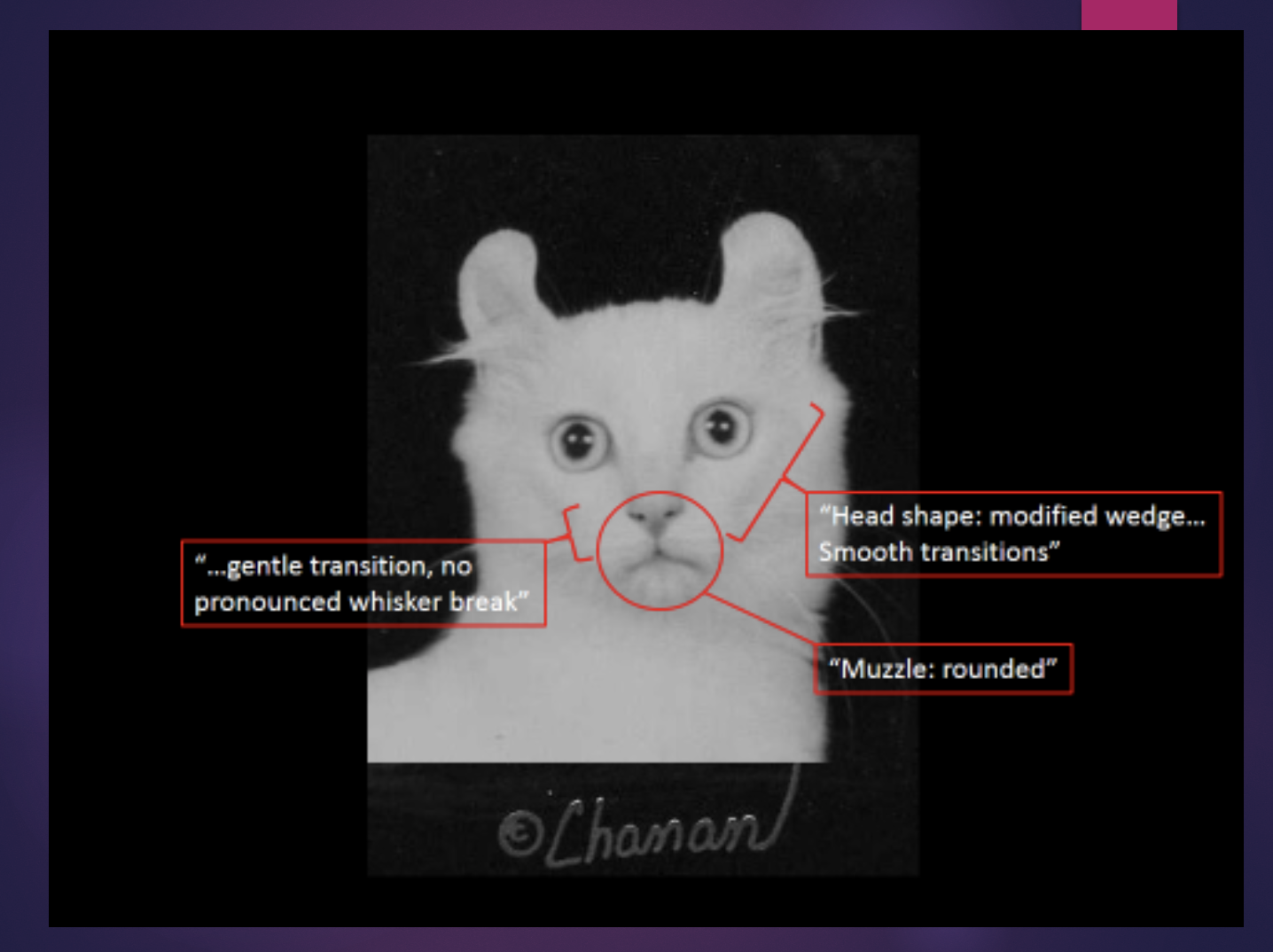
The CFA Standard was changed to read “Muzzle rounded with gentle transitions, no pronounced whisker break”
Immediately, the cats with ‘rounder’ heads and short faces began to place above cats with longer ‘correct’ faces.
Over the last 10-12 years, in researching why the impact was so profound, we found that those from an American Shorthair – Persian foundation of education tended to translate the term to ‘round’. Those with a Siamese/Oriental foundation of education understood the phrase to mean’ round off the extreme point of a true wedge’. The last interpretation, is closest to the intended application of the terminology.
Over the last 6-8 years, a new generation of Curl breeders have come to the forefront here in CFA. There have been years of frustration with how far the American Curl has drifted from its CORE IDENTITY TRAITS.
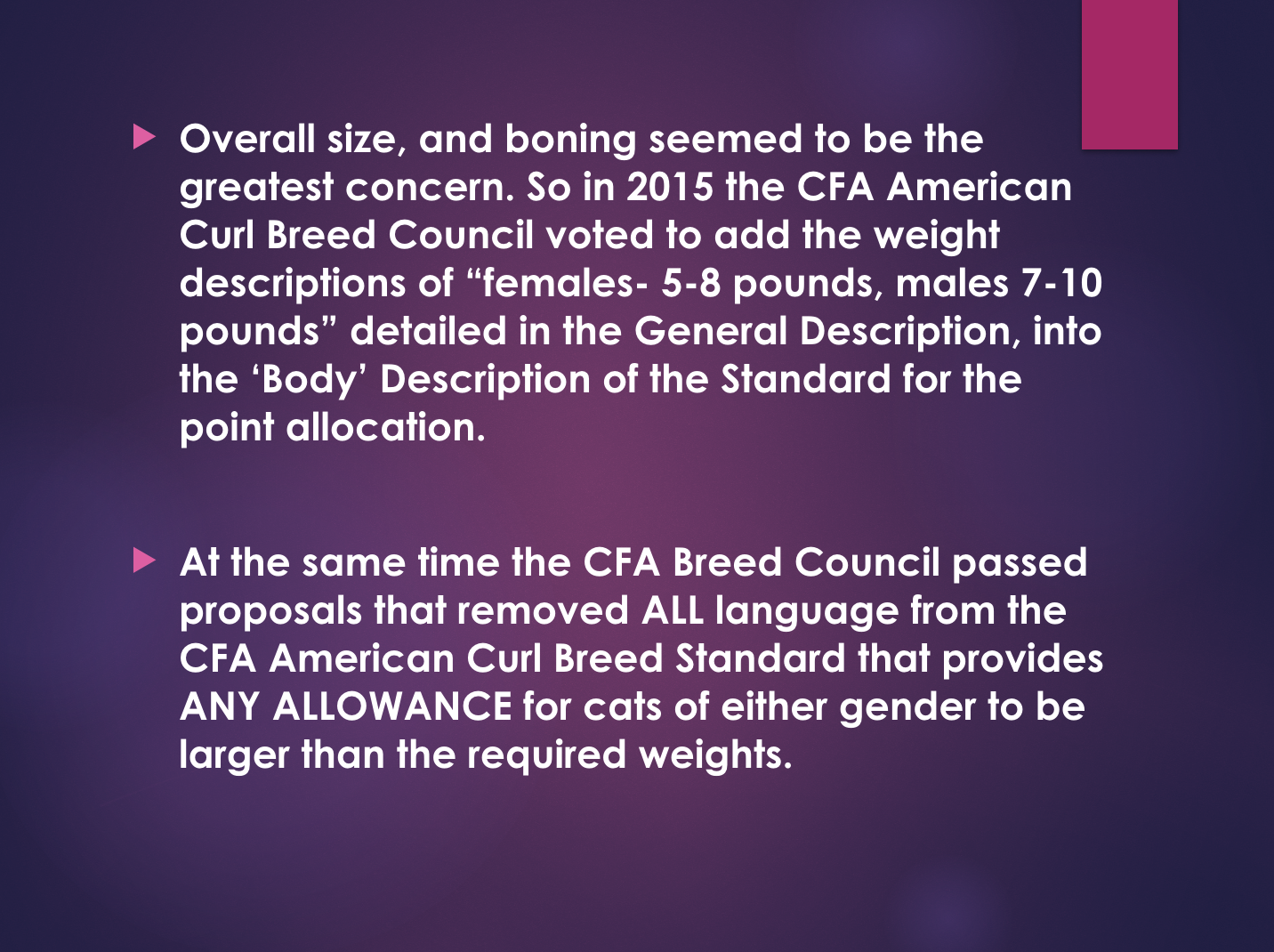
Overall size, and boning seemed to be the greatest concern. So in 2015 the CFA American Curl Breed Council voted to add the weight descriptions of “females- 5-8 pounds, males 7-10 pounds” detailed in the General Description, into the ‘Body’ Description of the Standard for the point allocation.
At the same time the CFA Breed Council passed proposals that removed ALL language from the CFA American Curl Breed Standard that provides ANY ALLOWANCE for cats of either gender to be larger than the required weights.

We actually use a dressmakers tape and measure foreleg boning in our breeding program and recommend others do the same, to assess and identify what is outside of desired body structure guidelines. This also helps maintain overall body size and weight.
These recent Standard changes are causing a ‘Course Correction’ in the American Curl Structure and Size currently. The Breed Council is thrilled that once again, the Curls have set precedence in CFA, by having weights stated in the body of our Breed Standard.
We as a Breed Council are grateful beyond words for the CFA Board approval of this. We feel this decision, is restoring our American Curl Identity as a ‘5-10 pound, semi-foreign breed, with a semi-long coat that brings all the attention to our large curlvaceous ears!’
In closing, Michael Bull has requested I ‘judge’ an American Curl for you.
(video)
I will explain what I am assessing, through the entire process, identifying both positives and less positive traits.
This is Joe’s cat, so you don’t need to feel sorry for the owner, although he can be just as cattery blind as anyone else when emotionally attached!
The End
Written and Presented by: Grace Ruga to The World Cat Congress April 2017 in Las Vegas NV
